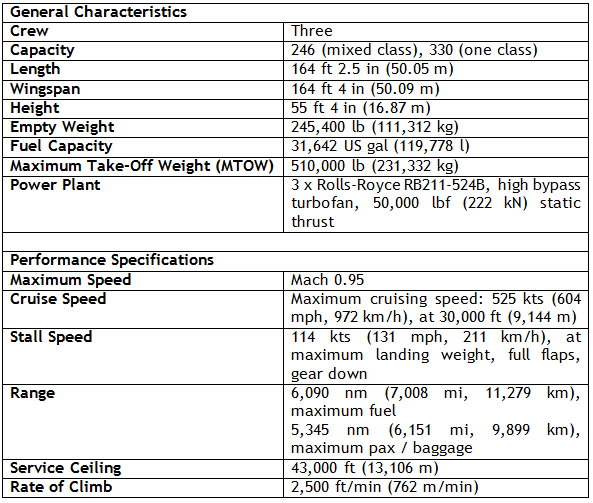.
L-1011 'TriStar' Professional and L-1011 'TriStar' Livery Packs
For FSX/Prepar3D Published by Just Flight
Reviewed by Andrew Godden
March 2015
Introduction
Lockheed and the iconic L-1011 'TriStar' need no introduction. The
'TriStar' was Lockheed's opportunity to re-enter the commercial
airliner market after several years of absence and this wide body
airliner of the 1970s came from a period of significant development
in the commercial airline industry. This was reflected in a design
which was more efficient and technically more advanced than its
competitors.
Just Flight have a longevity in the flight sim community for
producing and publishing high quality commercial airliner aircraft
and other add-ons for Microsoft Flight Simulator and other flight
simulator platforms. After releasing the original L-1011 'TriStar'
product some two years ago, Just Flight have now released this
iconic aircraft in a 'Professional' version which sees a return to
the highly detailed and modelled systems which are synonymous with
the Just Flight 'Professional' product range. Just Flight also have
three separate livery packs available for the aircraft.
History
The Lockheed L-1011 'TriStar' is a medium to long range, wide body,
trijet airliner. It has a seating capacity of up to 400 passengers
and a range of over 4,000 nm (7,410 km). Commonly referred to as the
L-1011 (pronounced "L-ten-eleven") or 'TriStar', its trijet
configuration of a Rolls-Royce RB211 engine under each wing, and a
third, centre mounted RB211 engine with an S-duct air inlet embedded
in the tail and the upper fuselage, is distinctive.
The L-1011 'TriStar' was produced in two fuselage lengths. The
original L-1011-1 first flew in November 1970 and entered service in
1972. The shortened, long range L-1011-500 first flew in 1978 and
entered service in 1979. The L-1011-1 was also produced in a high
gross weight variant and subsequent production variants provided
further increases to take-off weights. The aircraft's design
incorporated some pioneering technologies, including a highly
advanced autopilot system, providing an auto landing capability, and
an automated descent control system, the Direct Lift Control (DLC)
system. Consequently, it was the first wide body airliner to be
certified for CAT IIIc auto landings. The aircraft's design features
also included a lower deck galley and lounge facilities.
The 'TriStar' was the third wide body airliner to enter commercial
operations after the Boeing 747 and the McDonnell Douglas DC-10.
When production ended in 1984, Lockheed had manufactured a total of
250 'TriStars'. The aircraft's sales were hampered by two years of
delays due to developmental and financial problems at Rolls-Royce,
the sole manufacturer of the 'TriStar's' engines. After production
ended and due to the 'TriStar's' below target sales, Lockheed
withdrew from the commercial aircraft business entirely.
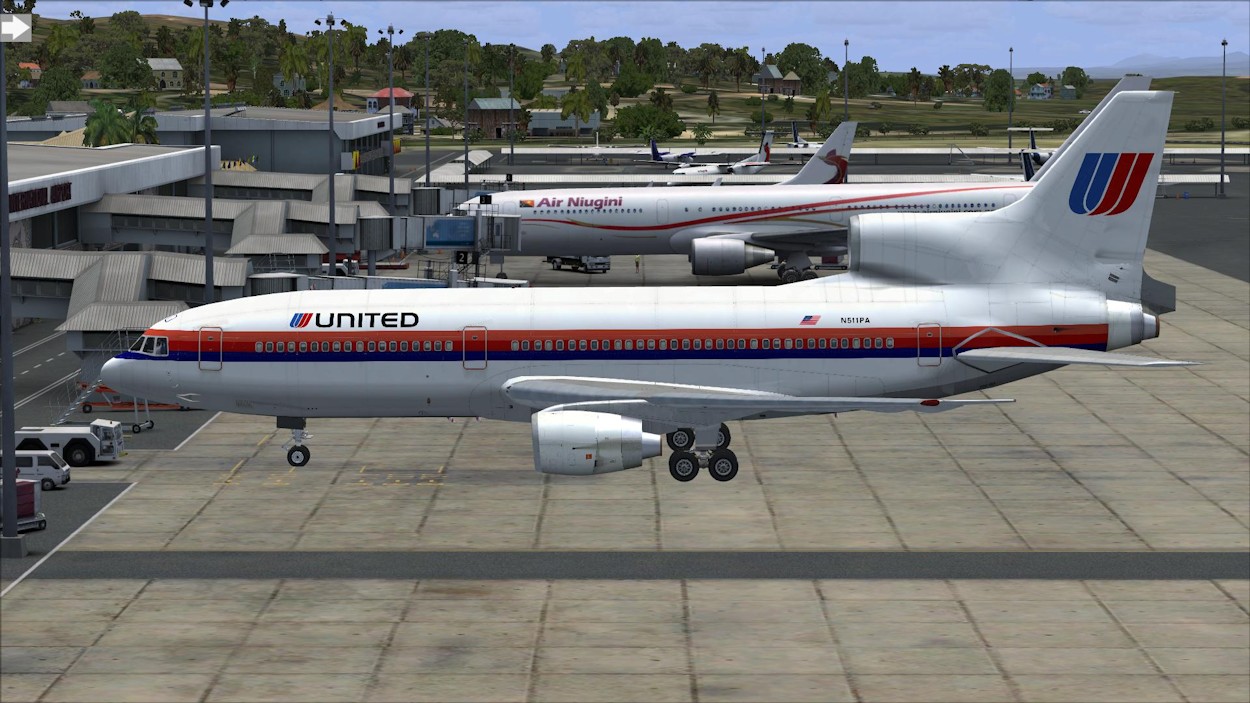
Lockheed L-1011-500 'TriStar'
Availability and Installation
The L-1011 'TriStar' Professional is currently available direct from
Just Flight as a 'download only' product. It is priced at £34.99, or
the equivalent on currency cross rates. The download file size is
806MB and it requires approximately 6.3GB of HDD space for
installation.
For owners of the original version of the Just Flight L-1011
"TriStar', the L-1011 'TriStar' Professional is also available in an
upgrade version. This is also currently available direct from Just
Flight as a 'download only' product. It is priced at £14.99, or the
equivalent on currency cross rates. The download file size is 807MB
and it requires approximately 6.3GB of HDD space for installation.
The three L-1011 'TriStar' Livery Packs are available as individual
products or as a Livery Bundle Pack containing all three products.
All are currently available direct from Just Flight as 'download
only' products. The individual Livery Packs are priced at £4.99
each, and the Livery Bundle Pack is priced at £9.99, or the
equivalent on currency cross rates. The download file size and the
required HDD space for installation varies for each of these
products. These details are available on the respective product
pages on the Just Flight web site.
The download and installation process is simple and seamless and
during installation you are required to log in to your Just Flight
account.
Model Features
The L-1011 'TriStar' Professional is provided with a single model,
the final production L-1011-500 variant. Also included are three RAF
variants, the TriStar C2 (passenger), TriStar K1
(cargo/tanker/transport), and TriStar KC1 (cargo/tanker/transport),
which were all based on the L-1011-500. In addition, the L-1011-500
is provided in an INS and FMC configuration, effectively doubling
the available aircraft. The model features listed for the L-1011
'TriStar' Professional are extensive and typical of models in the
Just Flight 'Professional' range.
The following summary of the major features provides a limited
overview of the extent of the detail included in these packages:
•
General:
• highly accurate L-1011-500 TriStar model , built over drawings and
plans of the real aircraft;
• accurate flight dynamics closely simulate the real aircraft
performance envelope - roll augmentation, direct lift control,
and
active control system are simulated;
• authentic sound set delivers the full force of the three
Rolls-Royce RB211 turbofan engines;
• multiple interior and exterior viewpoints;
• flight analysis tool – the flight analysis tools enables you to
monitor and log your flight, including airspeed, altitude, and fuel
flow
parameters, and also includes the ‘Live Map’ feature for
monitoring your current position, speed, and flight plan;
• comprehensive 160 page colour manual, including flight tutorial;
and
• Prepar3D v1/v2 compatibility.
•
Exterior:
• high definition 2048 x 2048 textures;
• animated flying surfaces, landing gear, doors, airbrakes, and
engine cowlings;
• highly detailed and accurately animated main landing gear with
complex struts, hydraulic lines and brake systems, realistic
suspension,
and accurate retraction routines;
• accurately modelled, six stage, Fowler flaps and spoilers;
• lighting and special effects include strobes, beacon and
navigation lights, and landing lights correctly modelled into the
leading edges
of the wings;
• fully modelled passenger and lower deck cargo doors;
• animated large fuselage freight door on KC1 variant;
• air stairs for the forward and aft passenger doors;
• cargo loader for military variants with large fuselage cargo door;
• animated windscreen wipers;
• accurately modelled and animated twin centre line hose and drogue
in-flight refuelling system on the K1 and KC1 models;
• military variants feature accurately modelled directional infrared
counter measure devices;
• specular map to give realistic light effects on the aircraft
surfaces; and
• bump mapping to give a more realistic 3D effect to aircraft
liveries.
•
Interior:
• fully functional virtual cockpit with nearly all switches, knobs,
and levers animated and functional;
• highly detailed virtual cockpit, including engineer's panel (with refuelling controls on the K1 and KC1);
• authentic gauges and navigational equipment, including RMI, HSI
and INS;
• 3D primary instruments (Captain and First Officer) for increased
readability and smoothness:
• attitude direction indicator (ADI);
• horizontal situation indicator (HSI);
• radio distance direction magnetic indicator (RDDMI);
• airspeed indicator (ASI);
• vertical speed indicator (VSI); and
• altimeter.
• fully functioning Flight Engineer’s panel:
• hydraulic system (including PTUs, AC pumps, and RAT);
• electrical system (including ground power);
• engine bleed control system (including cabin temperature control);
• fuel system (including fuel transfer/cross-feed and dumping);
• cabin pressurisation system; and
• miscellaneous systems (ECS monitor, slat monitor, brake
temperature monitor and many more).
• advanced FMS unit based on the Honeywell HT9100 FMS/CDU:
• LNAV and advisory VNAV;
• SIDs/STARs (with Navigraph support);
• POS INIT, PERF INIT, IDENT, RTE, LEGS, and DEP/ARR pages; and
• integrated fully with the autopilot.
• fully functioning INS unit for realistic navigation;
• functional autopilot/auto throttle system, including navigation
hold mode that can be linked to the INS or GPS unit and IAS (speed)
hold mode;
• analogue and tape engine instruments included;
• functional annunciators for engine and flight systems;
• radio suite, featuring DME, NAV, ADF, COMMS, and transponder;
• in-flight refuelling hose and drogue controls on engineer's panel;
• custom coded engine start sequence for increased realism;
• loss of hydraulic pressure can result in flight control and brake
failures;
• excessive brake usage can result in overheating, with associated
cockpit warnings/bells;
• functional slat monitor panel can be used to lock the position of
leading edge slats, irrespective of flap handle position;
• interactive checklist panel featuring checklists for every stage
of the flight;
• co-pilot call-outs, including take-off speeds (V1/VR/V2), gear,
and flap status;
• cabin announcements and interaction for all stages of flight from
departure to arrival;
• functioning tiller handle for direct nose-wheel steering;
• option to add third party weather radar to the virtual cockpit;
• ‘baked’ textures create an authentic used look to the virtual
cockpit area and controls;
• dramatic night lighting effects for the instruments and panels;
• fully featured 2D panel including numerous pop-up panels:
• engineer's panel;
• overhead panel;
• radio/pedestal panel;
• throttle quadrant;
• INS or GPS; and
• lighting panel.
• sim-icons in both the 2D and virtual cockpit for easy access to
pop-up panels;
• sim-icons for easy toggling of air stairs and cargo loader;
• standard and widescreen 2D panel included;
• 2D pushback panel – control pushback by setting pushback distance
(in feet or metres), direction (left/right), and angle (degrees);
and
• 2D speeds panel – input chosen V speeds (V1/VR/V2) and the virtual
co-pilot will call them out on the take-off roll.
Visual Appearance
General. Just Flight have done an excellent job with the level of
accuracy and detail in the 'TriStar' Professional. Nearly everything
is covered, as the features list attests to, and anything that is
not covered is probably superfluous to your flying of this aircraft
anyway.
Exterior. With the third, centred mounted engine embedded in the
tail and upper fuselage, the Lockheed L-1011 'TriStar' has very a
distinctive appearance, whilst still displaying the characteristic,
general wide body airliner lines. Just Flight have captured the
essence of the Lockheed L-1011 'TriStar' beautifully, with accurate,
detailed modelling and the high definition 2048 x 2048 textures
provide a very good balance between quality and performance. A
comparative review of photographs of real world aircraft to Just
Flight's rendition reveal the exterior shape and dimensions to be a
true representation of the real world aircraft. Any noted
differences are considered to be related to real world production
variations or a degree of artistic licence on the part of the
developer.
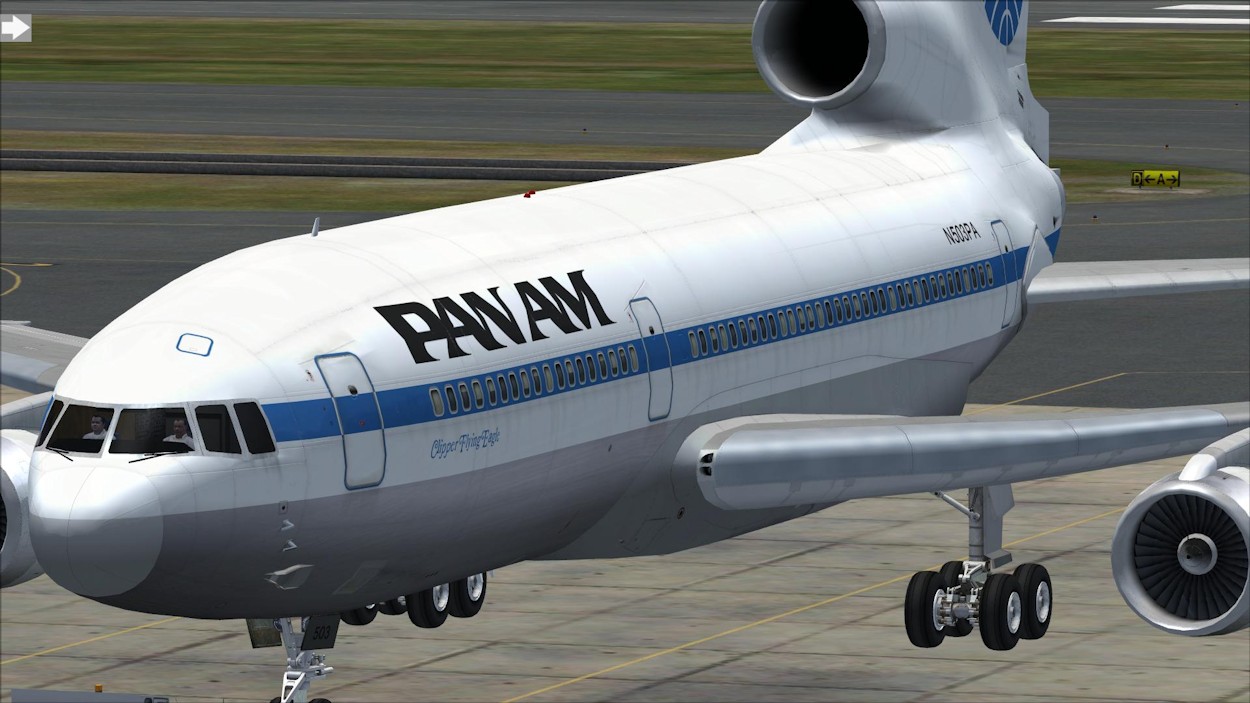
Nose Detail
|
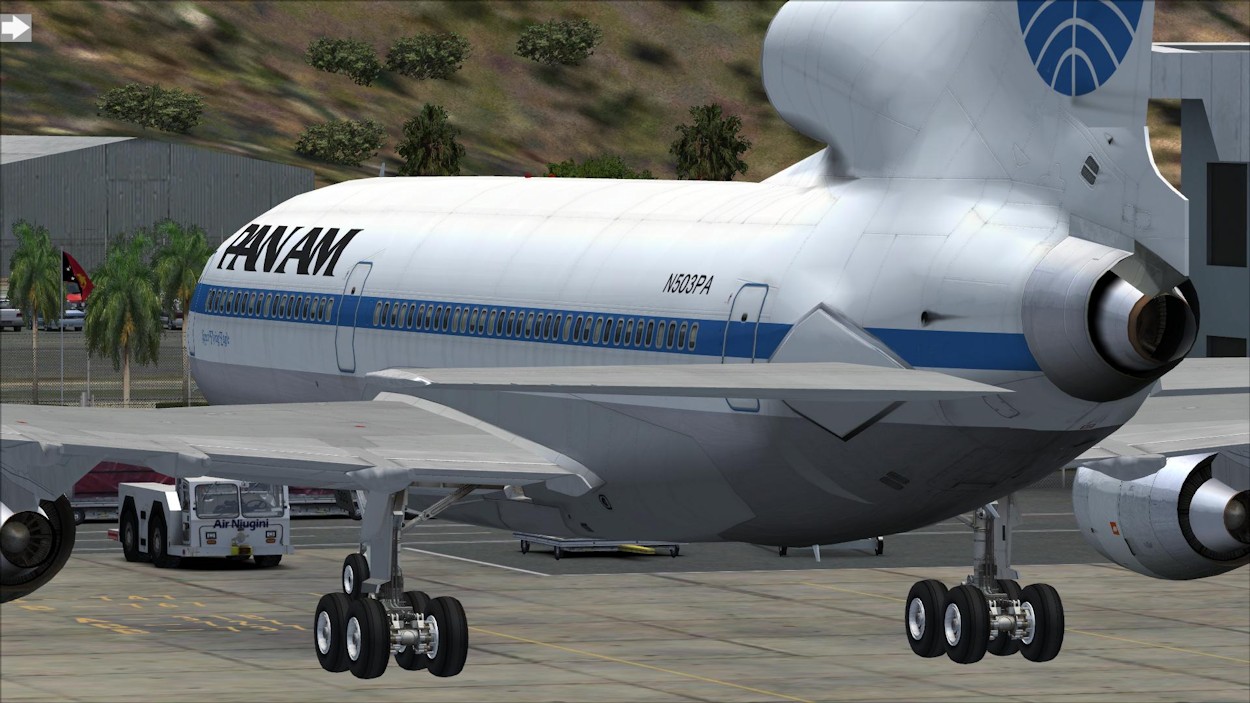
Tail Detail
|
Interior. The interior is the heart of where Just Flight have
focused their efforts in detail. A classic commercial airliner, the
Lockheed L-1011 'TriStar' has a classic analogue ('steam powered')
avionics suite. Daunting to the uninitiated, a classic analogue
cockpit is also mystifyingly beautiful. It is an environment which
gives you a sense of real hands on flying, an aircraft which you
actually have to fly and manage, and the addition of the flight
engineer's (FE) panel and the systems functionality associated with
this position further adds to the feel and complexity of flying this
magnificent aircraft. The level of systems functionality and detail
in the FE station alone can be overwhelming, particularly if you are
not familiar with them. The autopilot / auto throttle system will
help, as will the INS or FMC, but there is still a lot of flying to
be done in this aircraft. The modelling accuracy and detail of the
main panel, overhead panel, centre pedestal, and FE station are
exceptional and accurately compare with the layout of researched
photographs of real world aircraft.
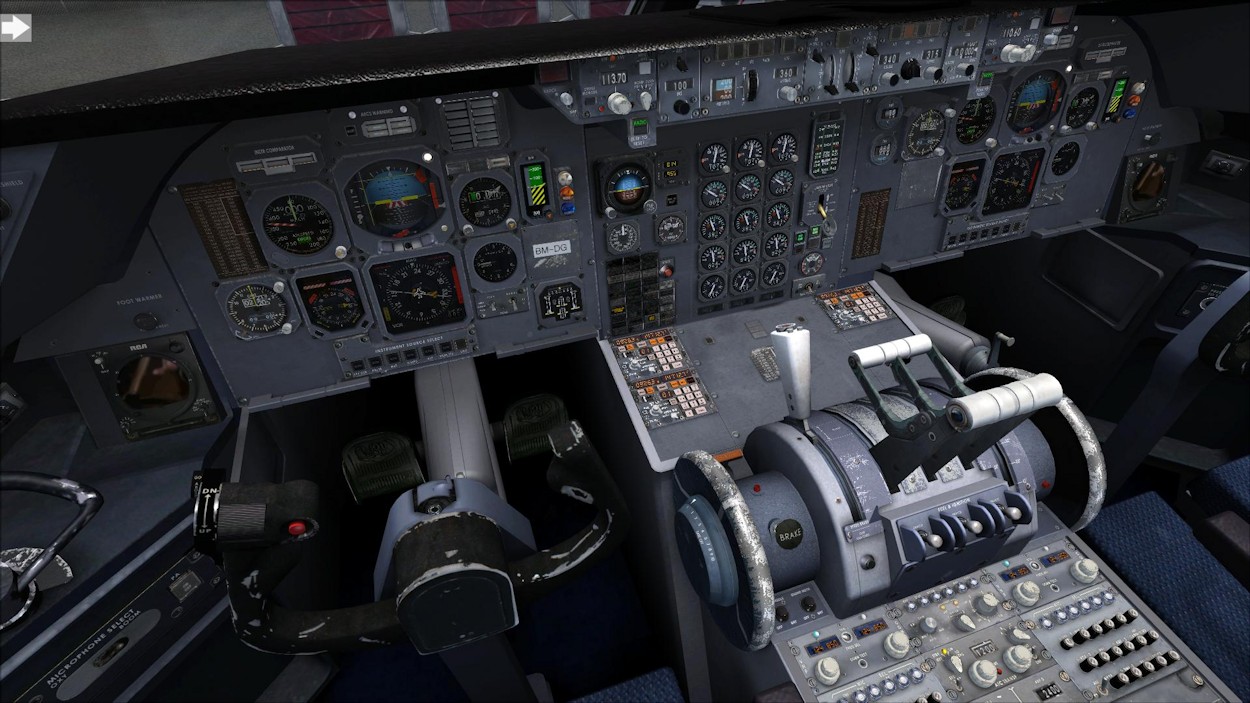
Virtual Cockpit 1
|

Virtual Cockpit 2
|
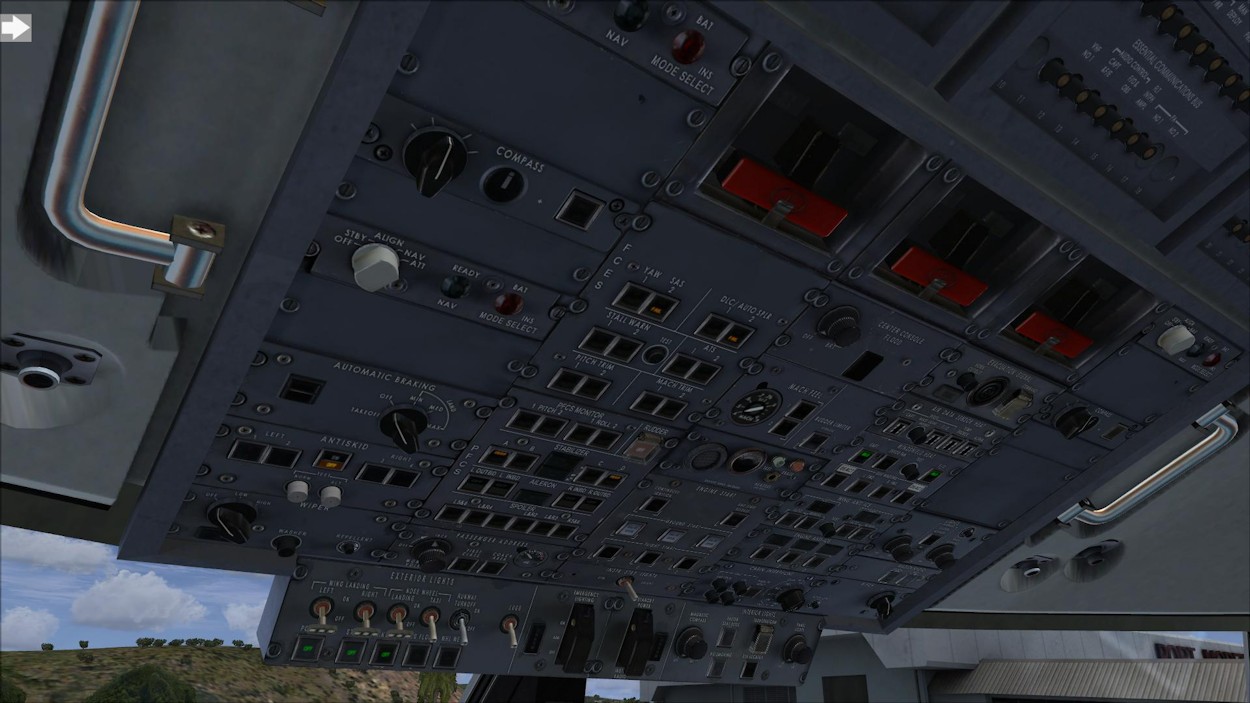
Virtual Cockpit 3
|
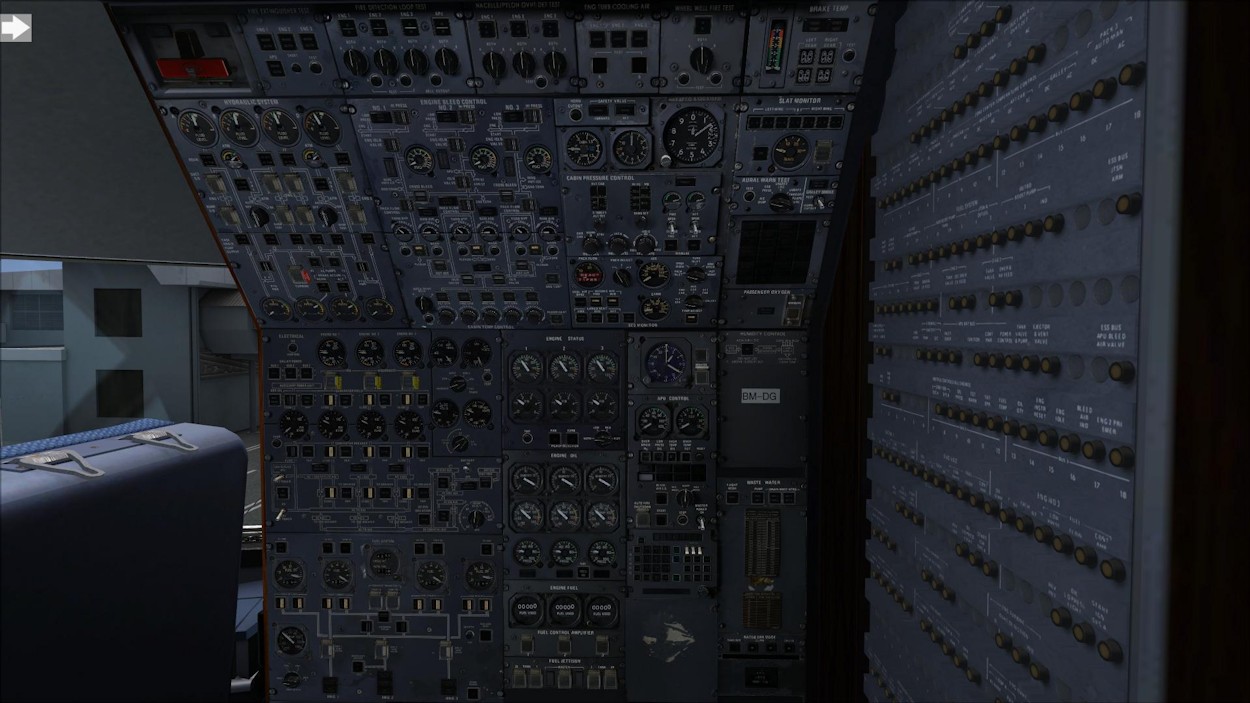
Virtual Cockpit 4
|
Flight Instruments and Systems. All major flight instruments and
systems in the 'TriStar' Professional are accurately represented and
fully functioning. As with other aircraft in the Just Flight
'Professional' range, this will definitely satisfy the yearning of
the procedural flight simmer. Whilst some aspects of systems
functionality have either been simplified or omitted, these are not
critical and certainly do not detract from the modelling or flying
of the aircraft. Even though this aircraft has a high level of
systems functionality, you can still immediately strap yourself into
the pilot's seat. After a quick cockpit familiarisation, set the
flaps to 'Flaps 10', advance the throttles, and you will soon be
airborne. Mind you, there will be some warning sounds blaring in
your ears until you are airborne, however, you can do what most of
us do when we install a new aircraft, and that is, just jump in and
fly. The instruments are magnificently detailed and clear and easy
to read and various alternative cockpit camera views and the 2D
panels are available to provide more detailed views of the
instruments. Some of the positioning and zoom levels of the
alternative cockpit views were not at an optimum for either viewing
or using the panels and this could have been improved significantly.
The user either has to readjust them each time or reconfigure them
in the panel.cfg files. Now, you might want to resolve those warning
sounds and so the manual becomes a
MUST READ at some stage. For
those not familiar with an INS or FMC, you will also need to
acquaint yourselves accordingly, and the manual covers these in
quite some detail and is a
MUST READ again. Oh, and by the way, if
you haven't got the picture yet,
read the manual.
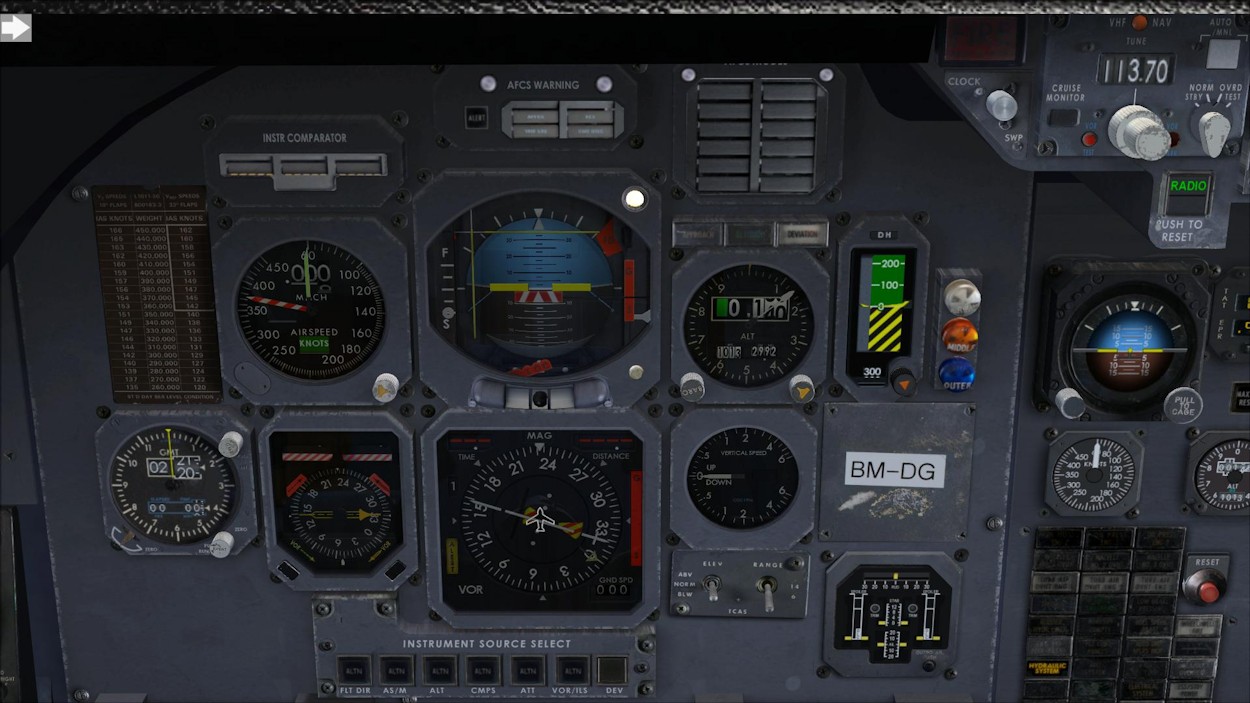
Captain's Flight Instruments
|
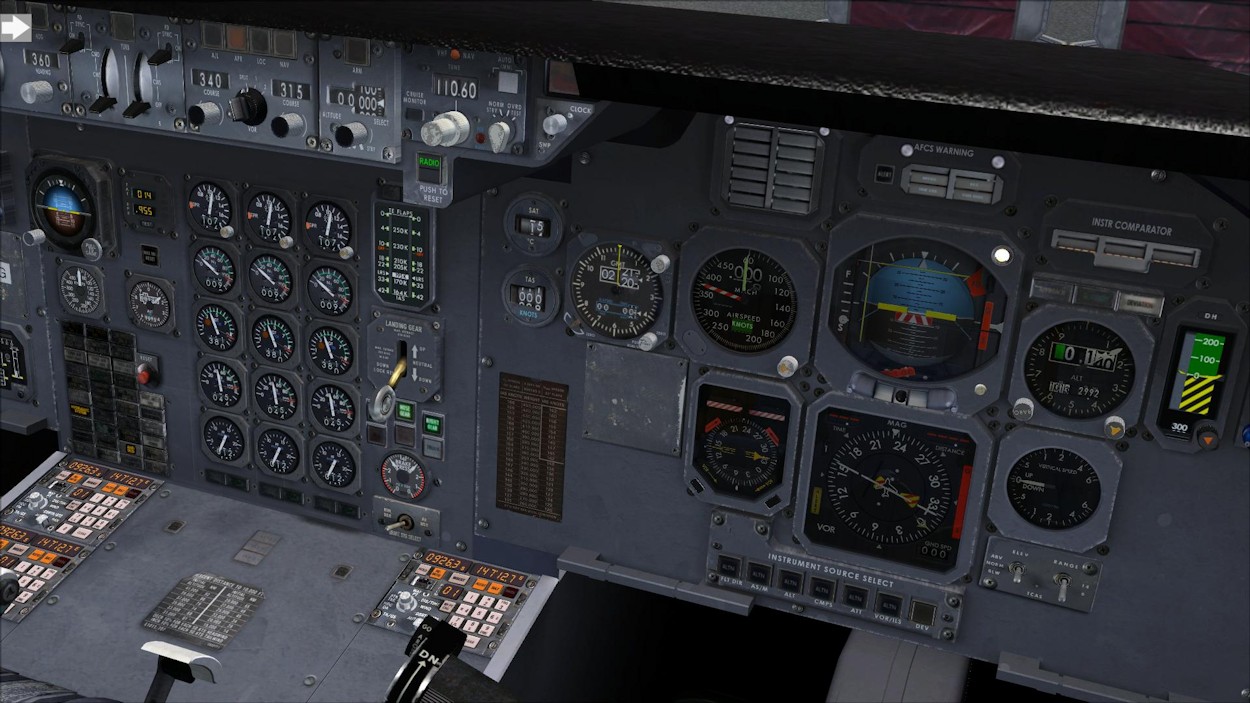
First Officer's Flight Instruments
|
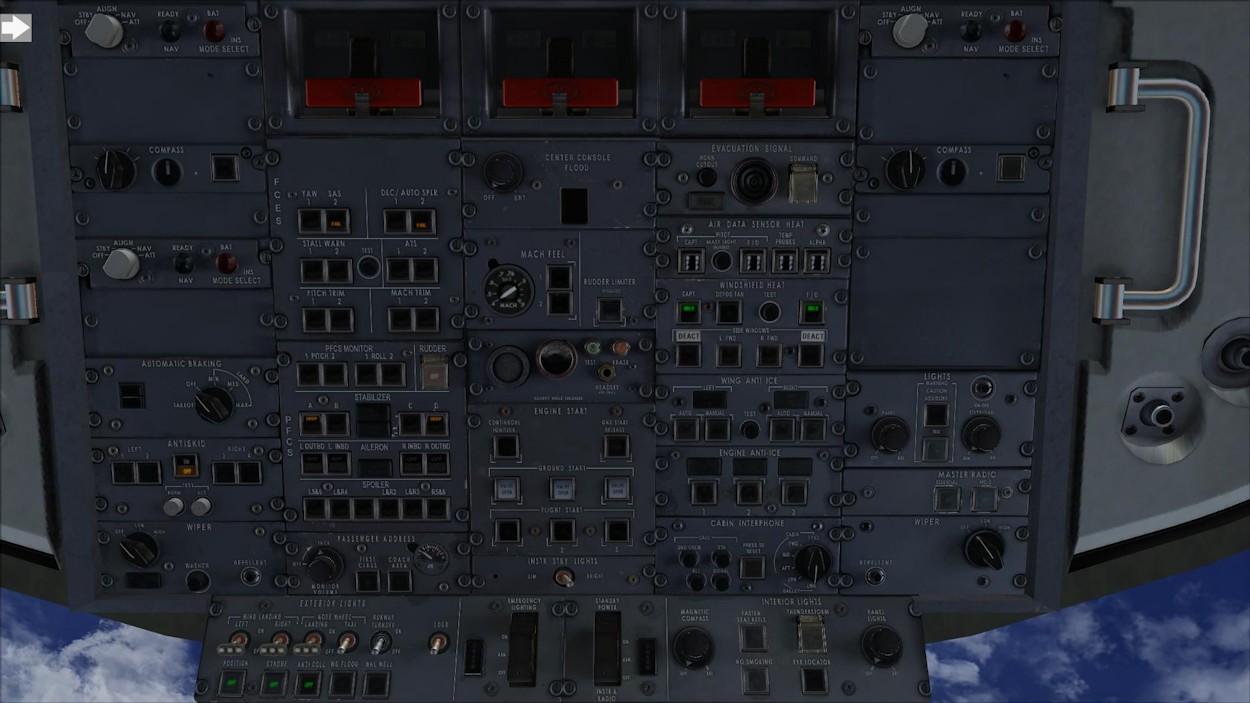
Overhead Panel
|
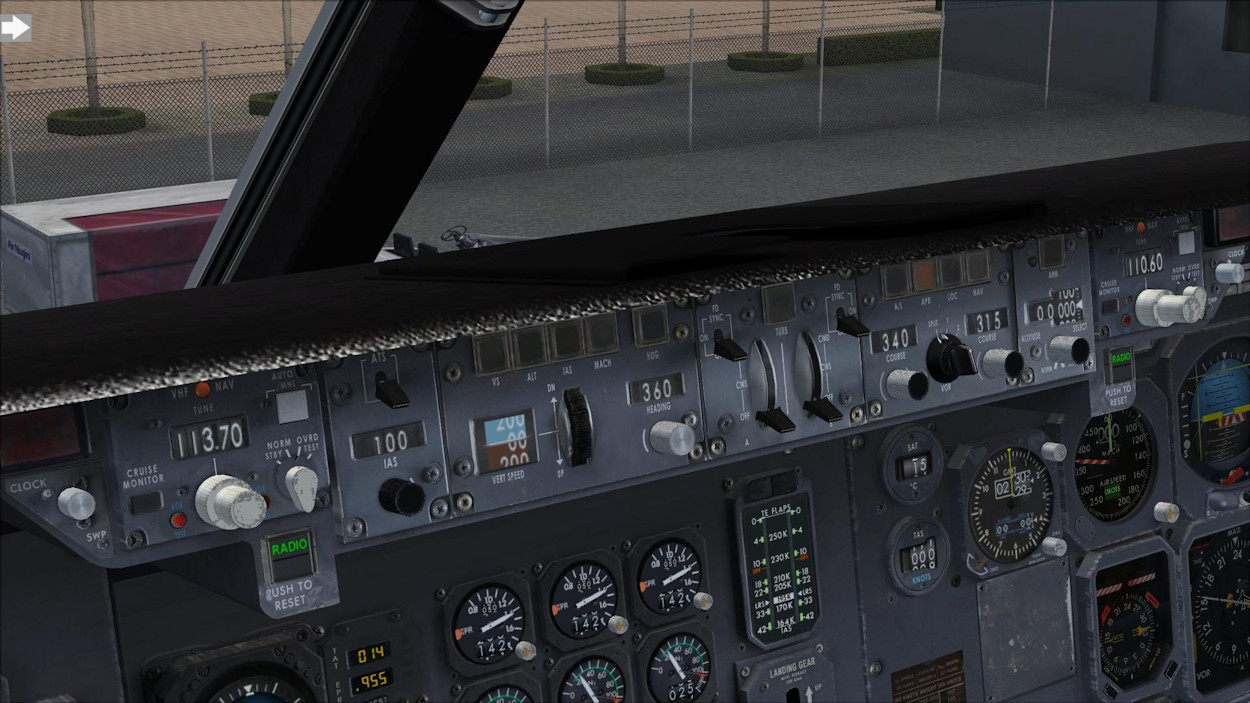
Autopilot & Auto Throttle
|
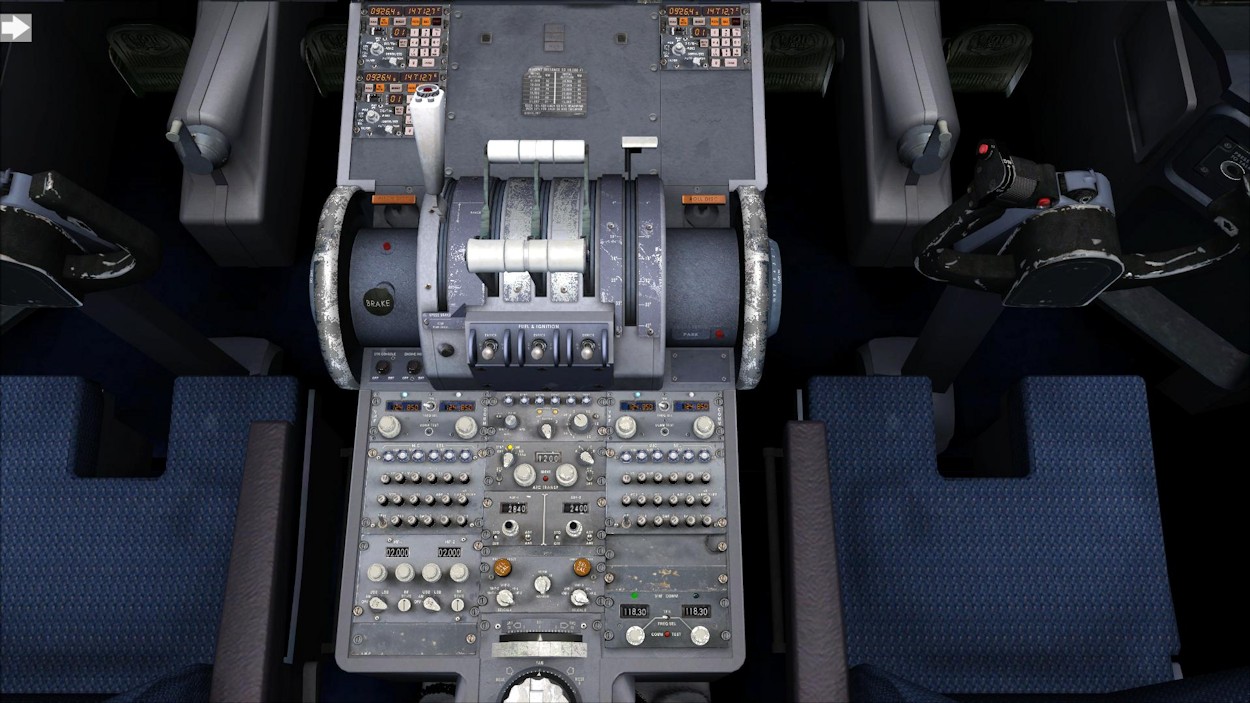
Pedestal Console with INS
|
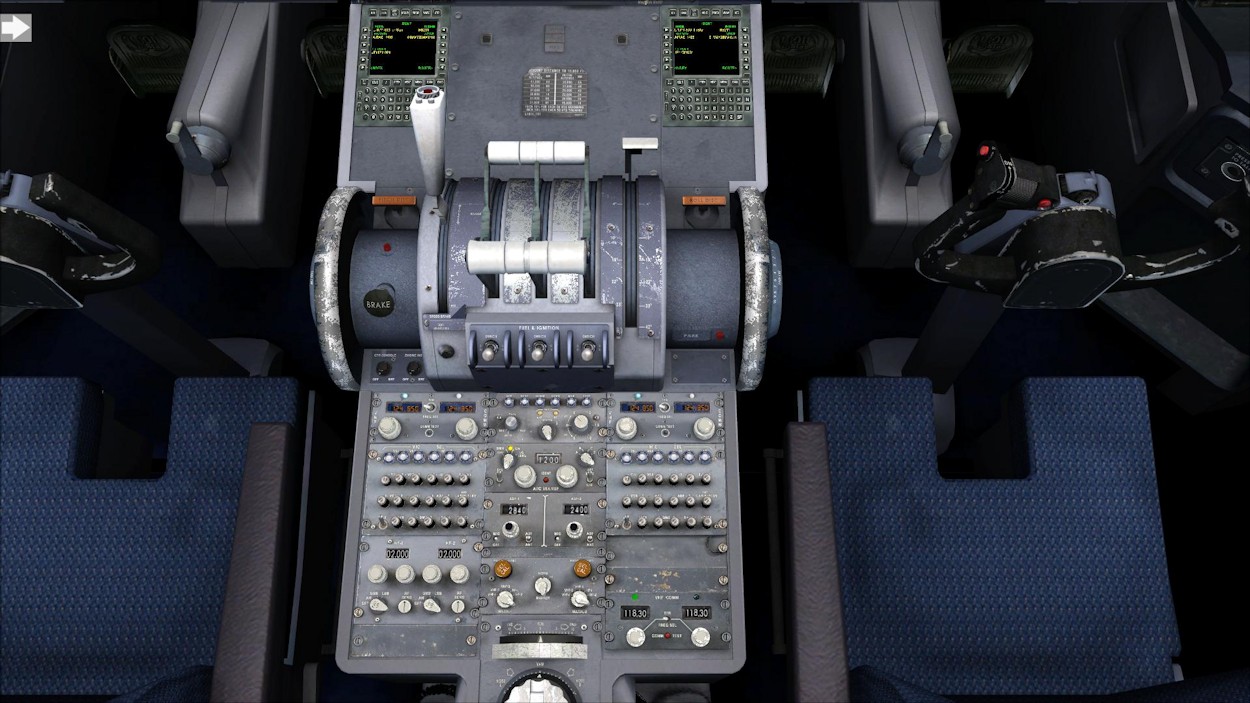
Pedestal Console with FMC
|
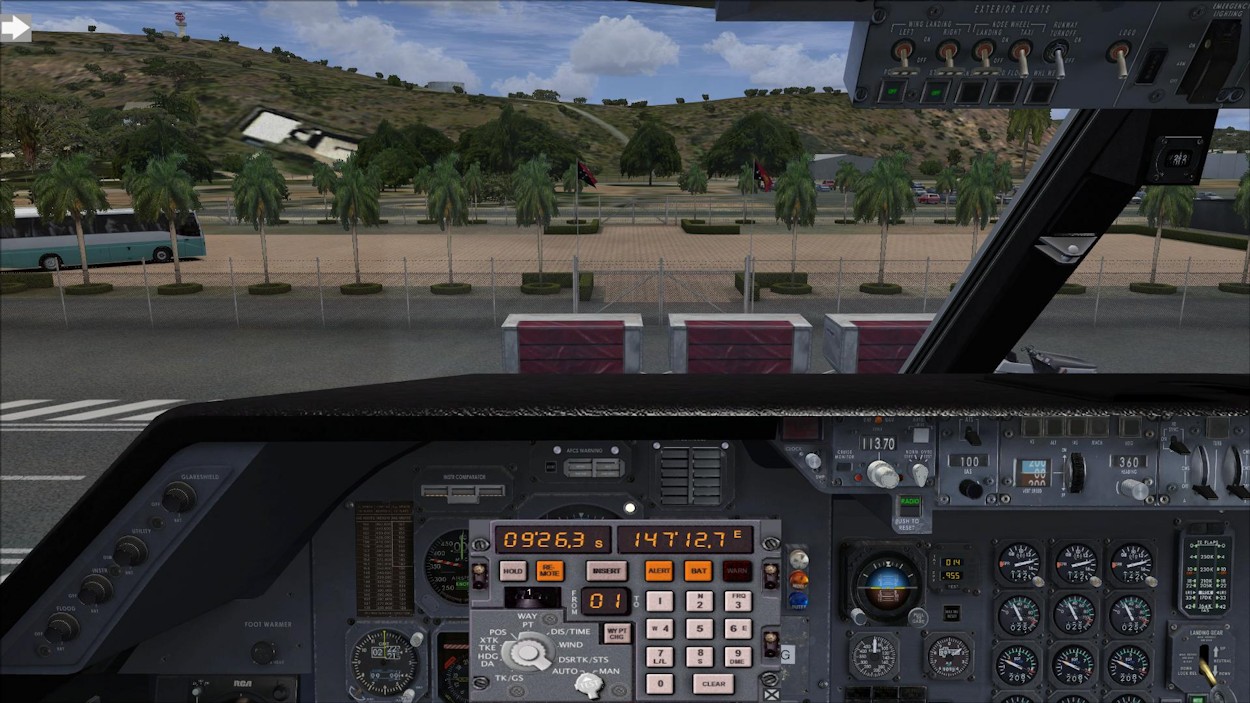
INS 2D Popup
|
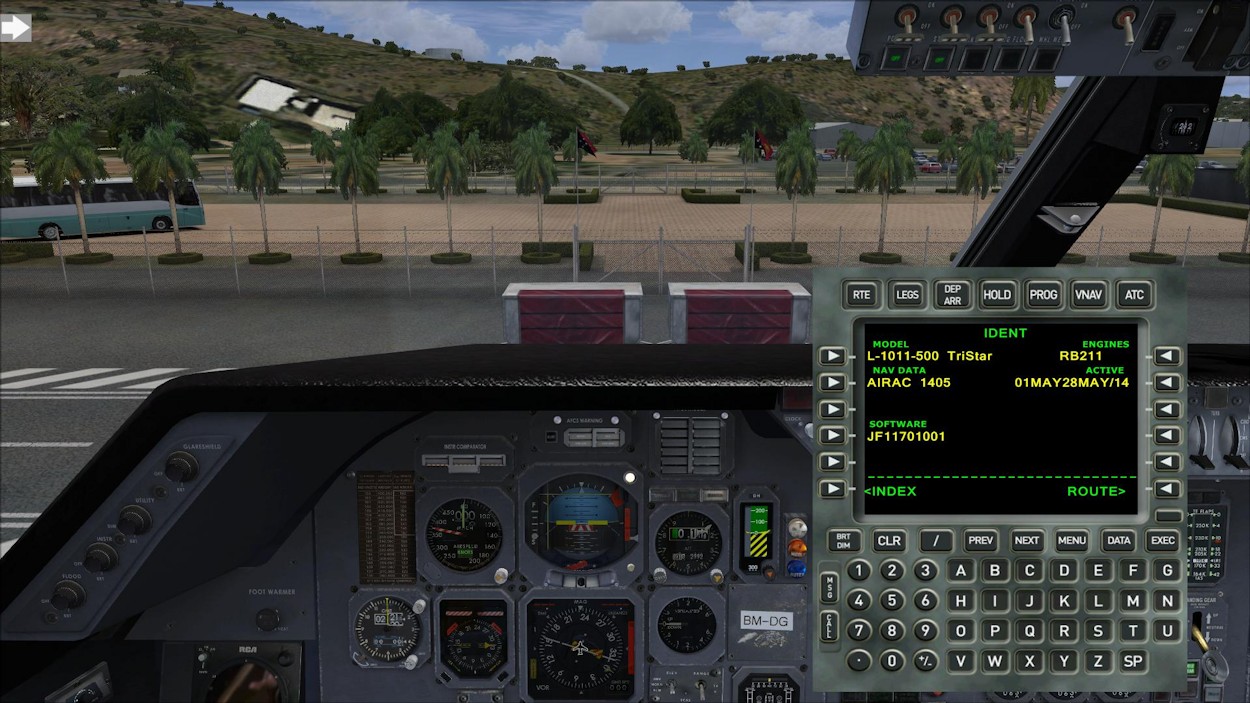
FMC 2D Popup
|
Liveries. There are 25 liveries (a selection only shown below)
included with the 'TriStar' Professional, as well as a blank texture
for aircraft painting enthusiasts. Each livery is provided in an INS
and FMC model, thereby doubling the number of aircraft available.
The liveries are of a high quality and the surface textures,
reflections, and shadings give the aircraft a crisp and realistic
appearance, with additional dirt, oil, and grease stains providing a
very natural appearance. The 'TriStar' Livery Packs provide a range
of additional liveries. Together, the three Livery Packs will
provide a total of 39 liveries, again, in both an INS and FMC model.
There is definitely no shortage of choice in the livery stakes with
the 'TriStar' Professional.
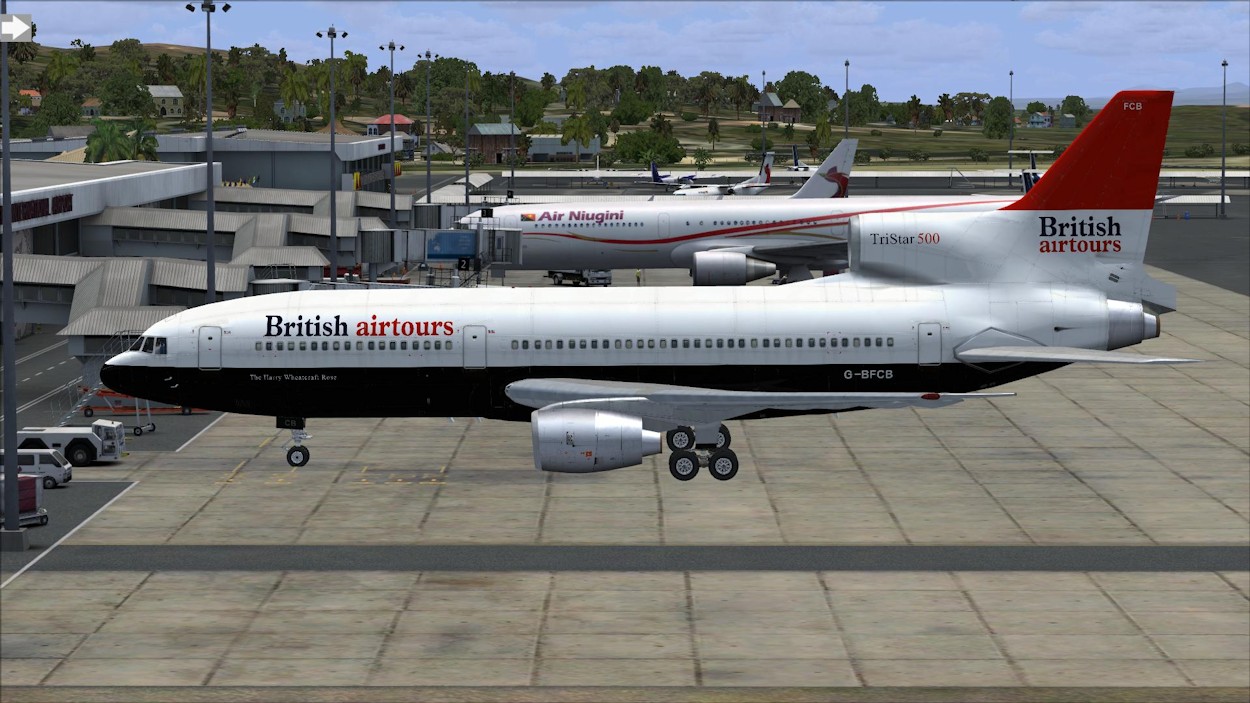
British Airtours
|
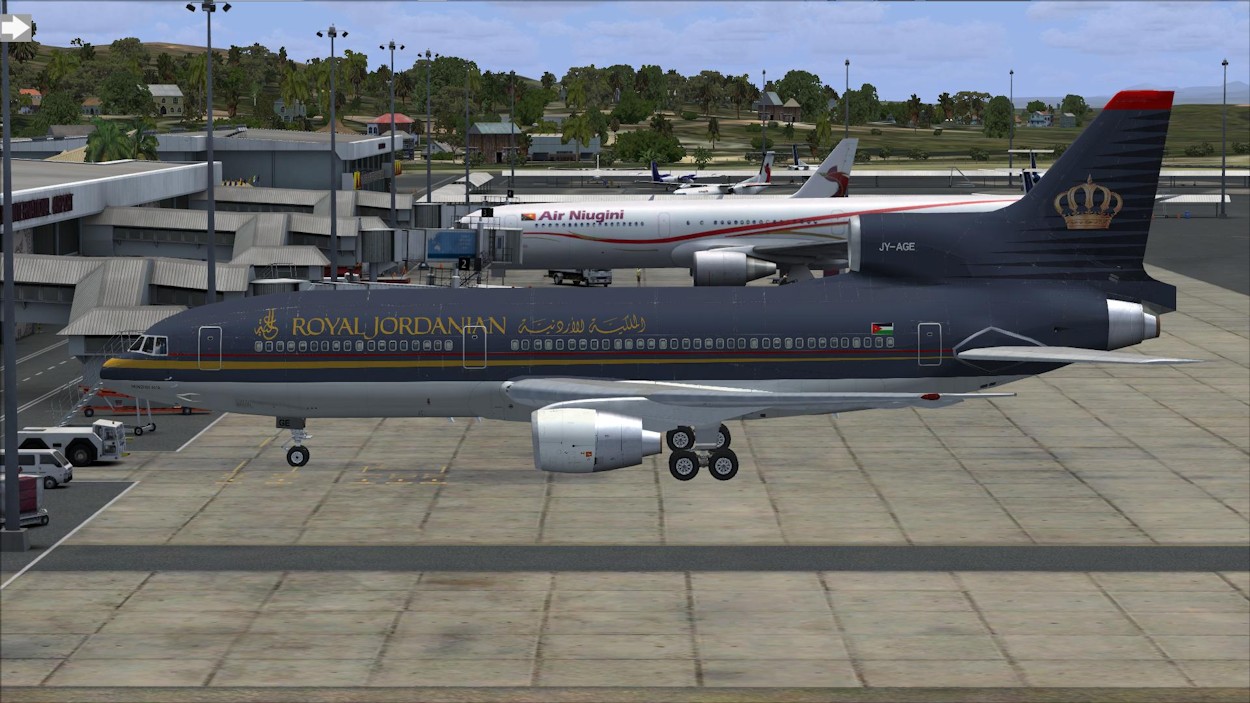
Royal Jordanian Airlines
|
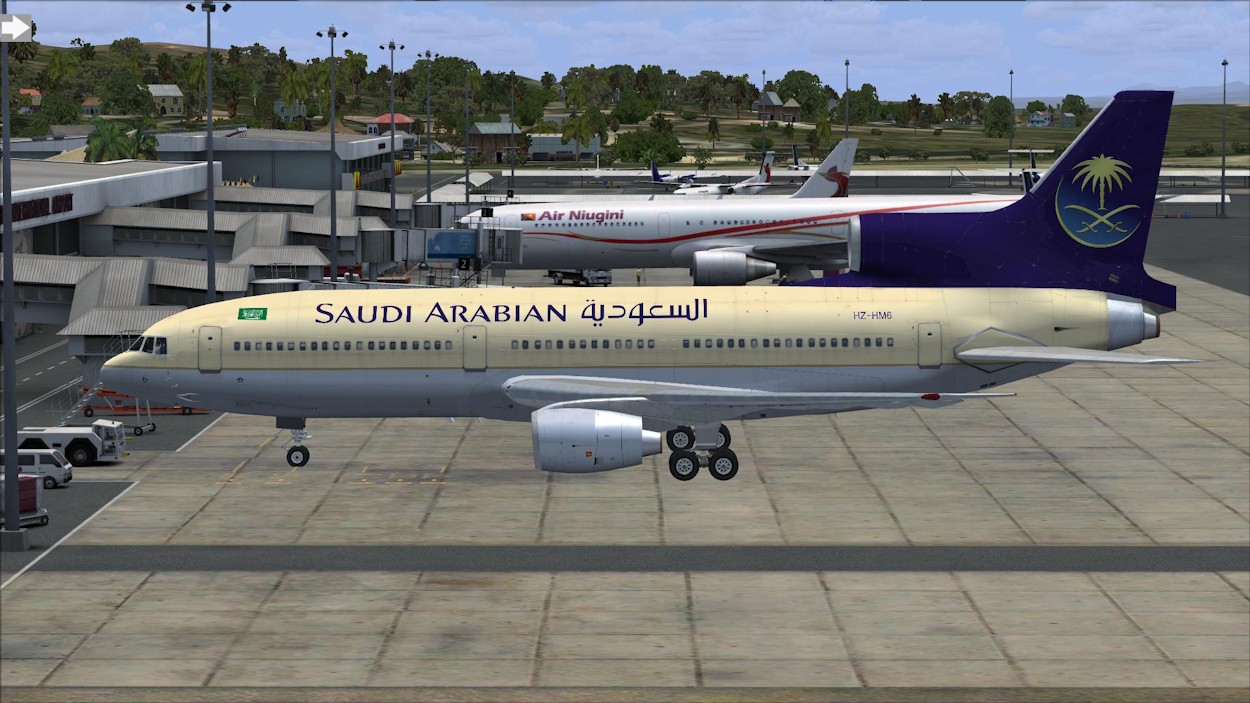
Saudi Arabian Royal Flight
|
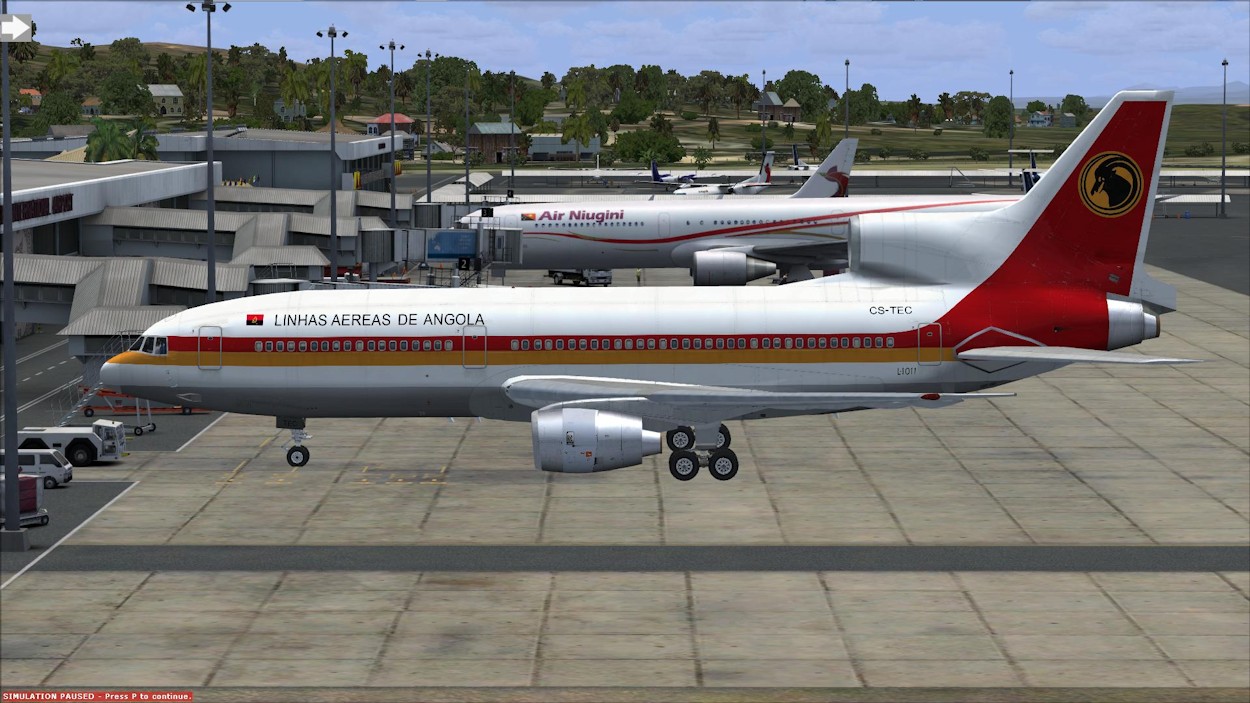
TAAG Angola Airlines
|
Animations, Lighting, and Sounds
As listed in the summary of major features, the animations on Just
Flight's 'TriStar' Professional are extensive. These are modelled to
the same high detail evident in other aspects of the product and all
appear to be modelled faithfully. The sim-icons control feature for
the air stairs and cargo loader is excellent, especially for those
who like to simulate to this level.
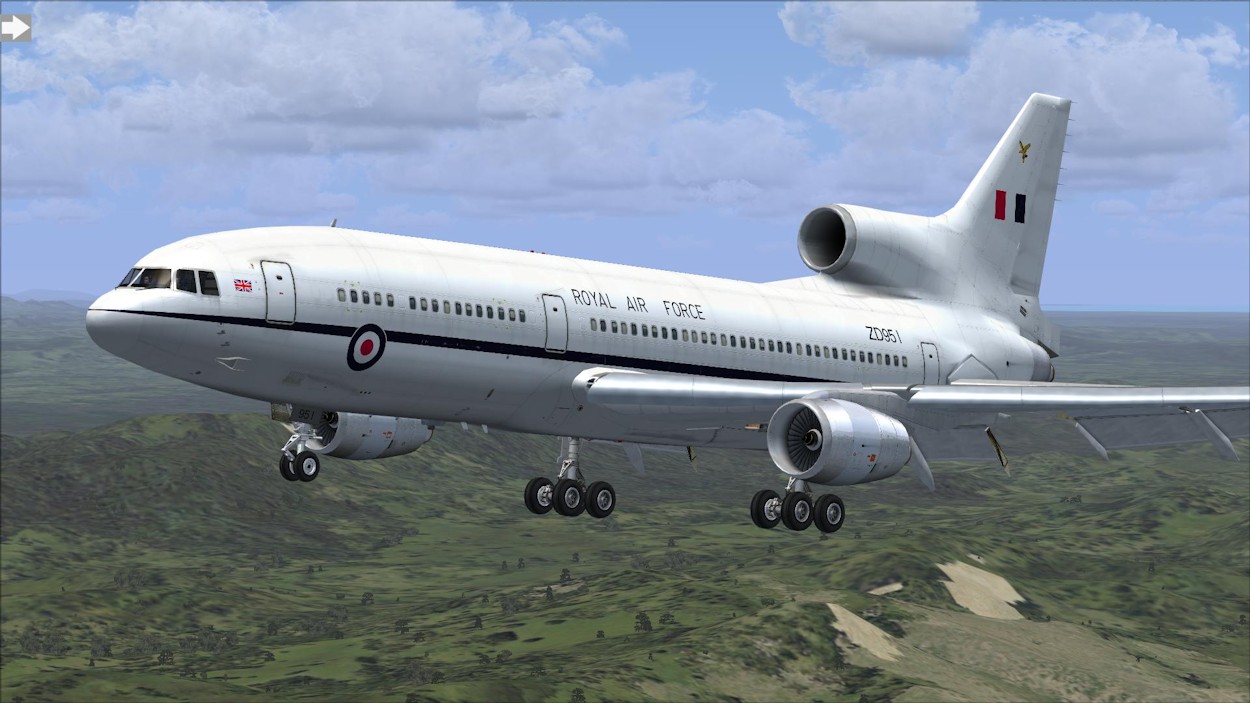
Configured for Landing 1
|
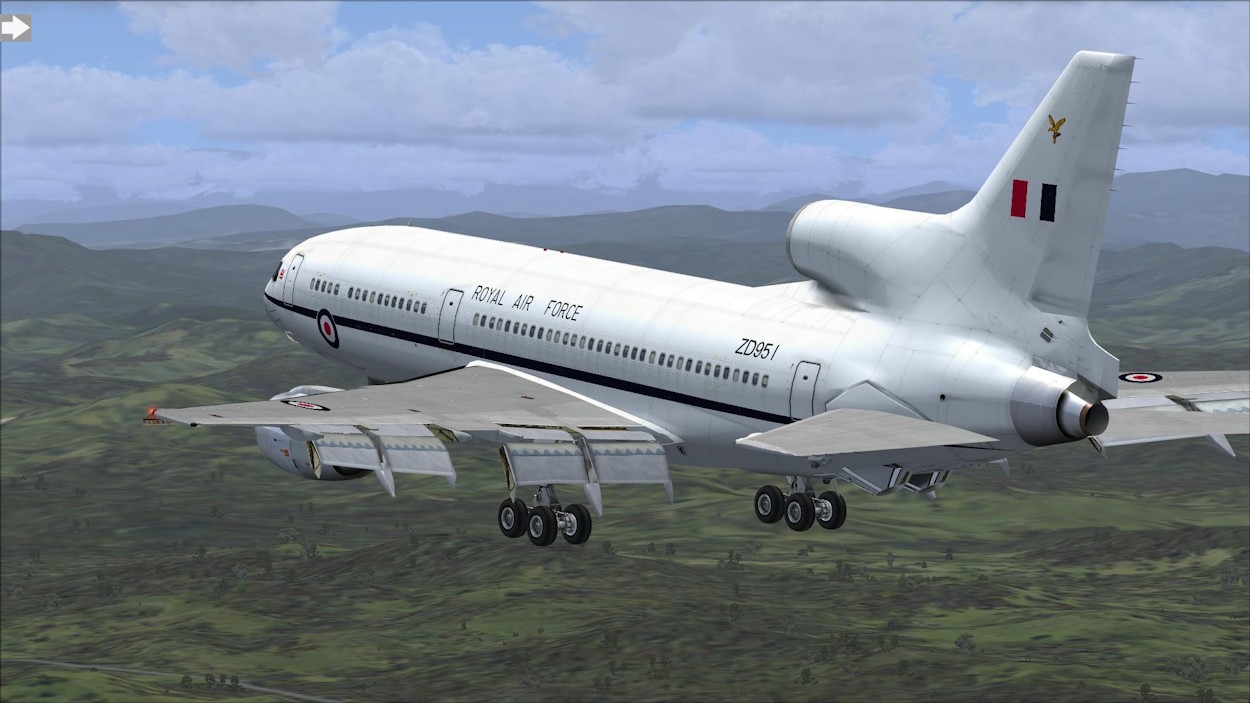
Configured for Landing 2
|
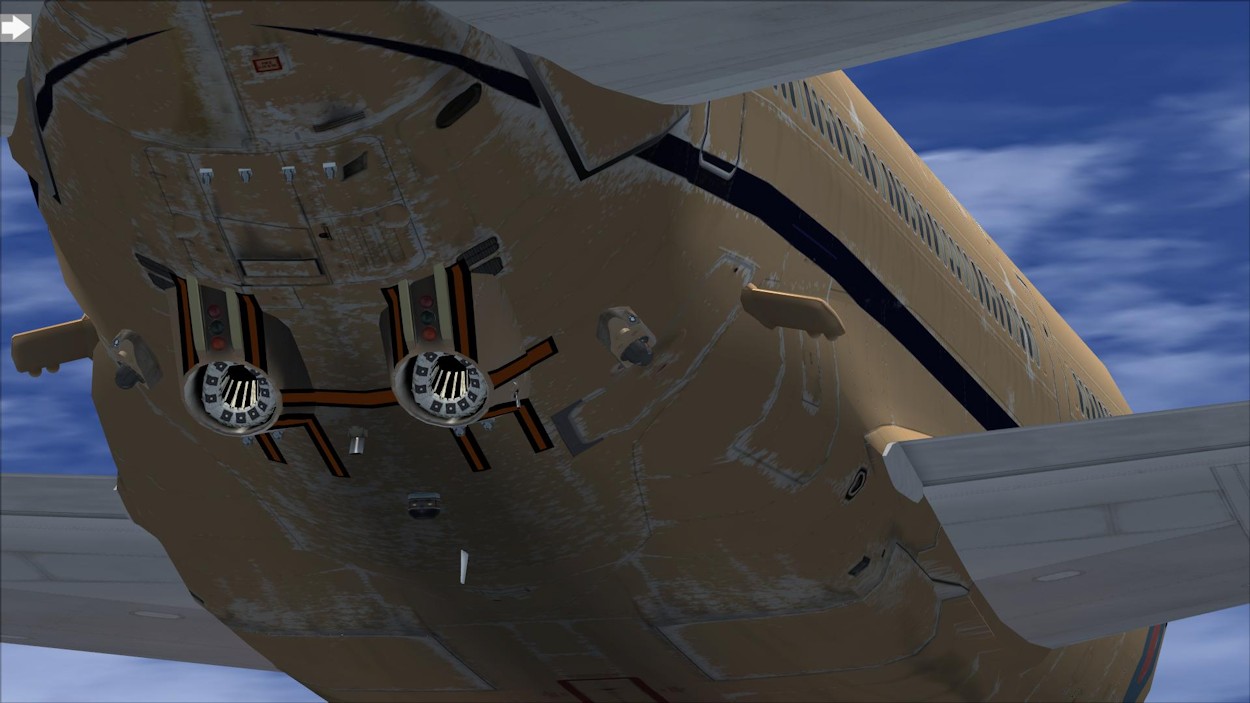
Refuelling Drogues Retracted
|
.jpg)
Refuelling Drogue Deployed (note the spread on the basket)
|
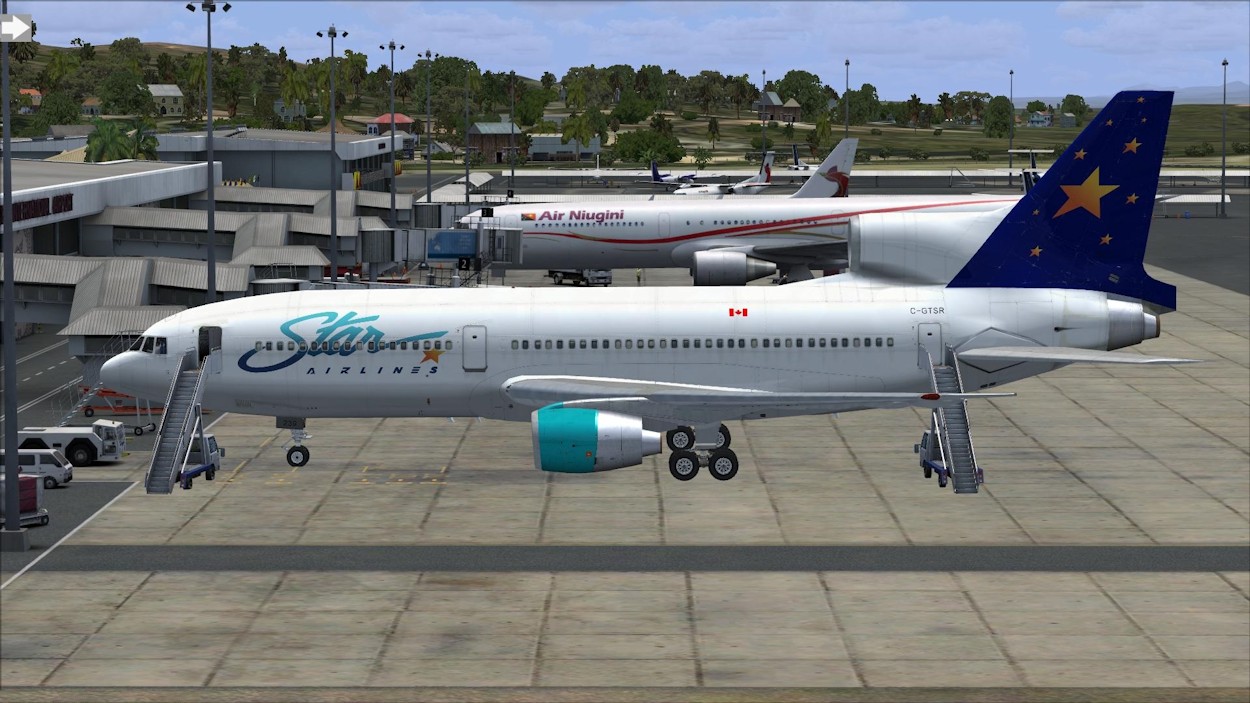
Air Stairs
|
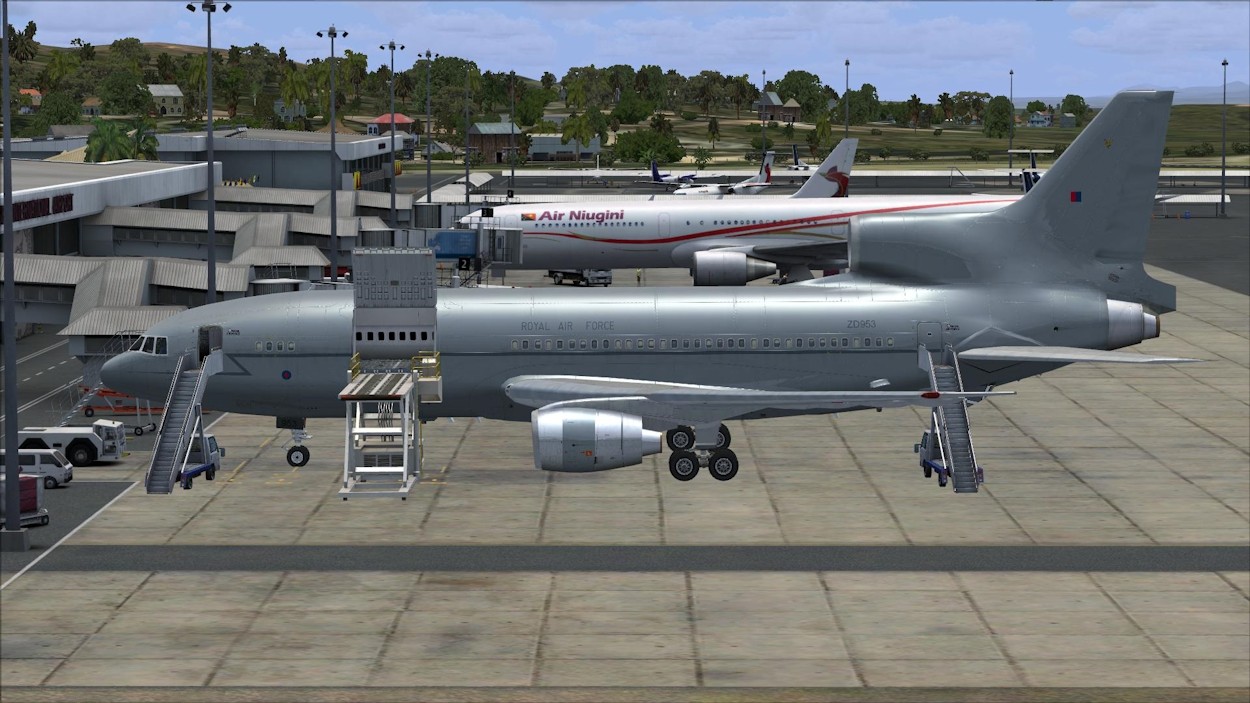
Main Deck Loader
|
The lighting and lighting effects on the 'TriStar' Professional are
a good, realistic representation of the real world aircraft and
replicate the night lighting seen in photographs of real world
aircraft.
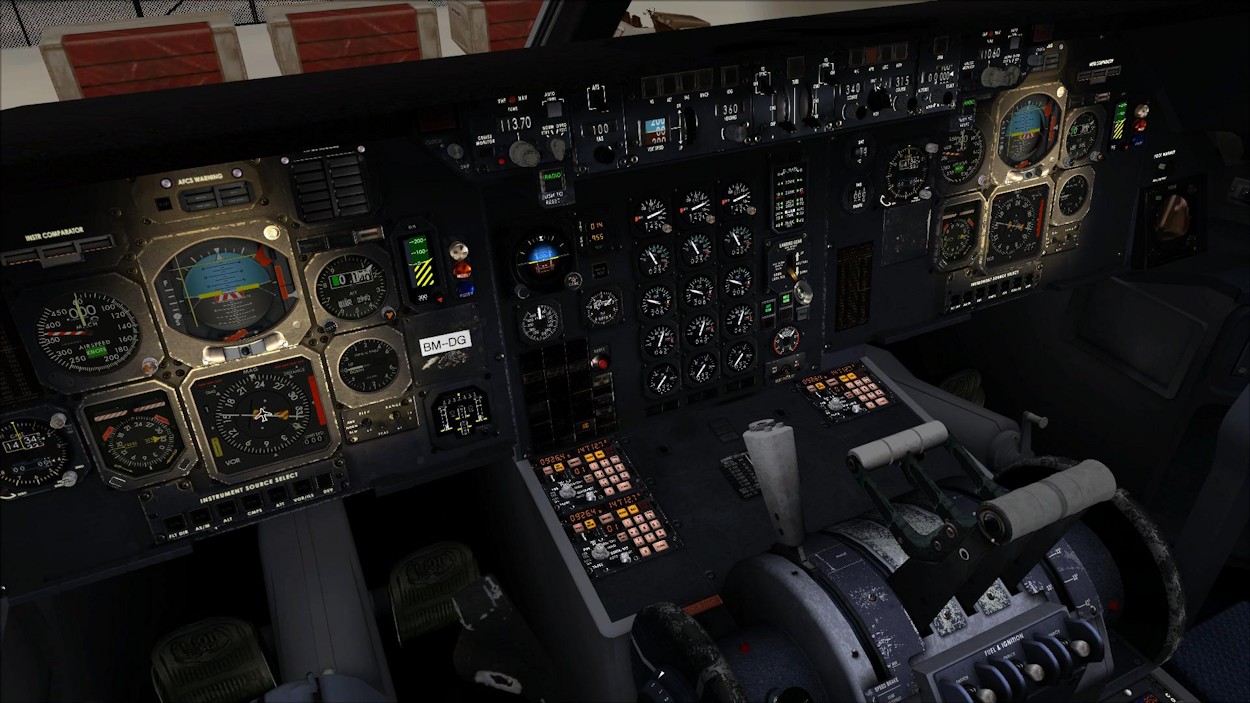
Instrument Lighting
|
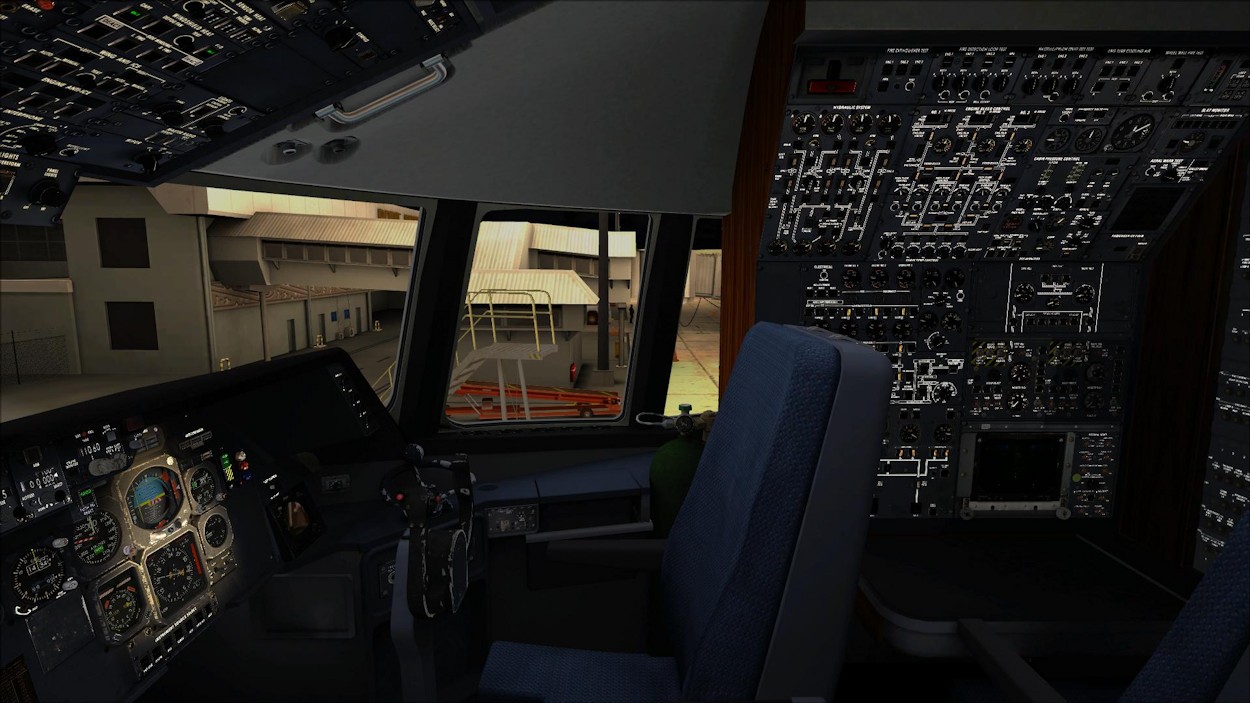
Cockpit Lighting
|
The sounds on the 'TriStar' Professional are reasonably realistic of
the real world aircraft, though it was only really possible to
review the engine sounds in videos of the real world L-1011
'TriStar'. Whilst the sounds were a good representation of the
Rolls-Royce RB211 engines, they seemed to lack a certain richness to
them and didn't give a true impression of the power behind the RB211
engine.
General Characteristics and Performance Specifications
The general characteristics and performance specifications for the
Lockheed L-1011-500 'TriStar' are provided in the table. This is
based on data from the data provided by Just Flight and general
research sources. Some of this data varies between sources and also
may be an approximation due to variances in data and the specific
aircraft modelled by Just Flight.
Flight Performance
Like most wide body aircraft, the L-1011 'TriStar' is a lot of
aircraft, yet surprisingly, once mastered, it is a gentle giant to
fly. However, close attention to the flight envelope, particularly
during the climb, is essential or this aircraft will punish you
mercilessly.
A specific Test Flight was conducted from Jacksons (AYPY) to Perth
(YPPH) to test the flight performance of the Just Flight 'TriStar'
Professional. The flight was conducted in clear weather with a full
fuel load and the aircraft at maximum take-off weight (MTOW). A
cruise altitude of FL340 was adopted and the route distance was
approximately 2,200 nm. The route was particularly chosen to provide
a basis upon which to test the range characteristics of the
'TriStar' Professional.
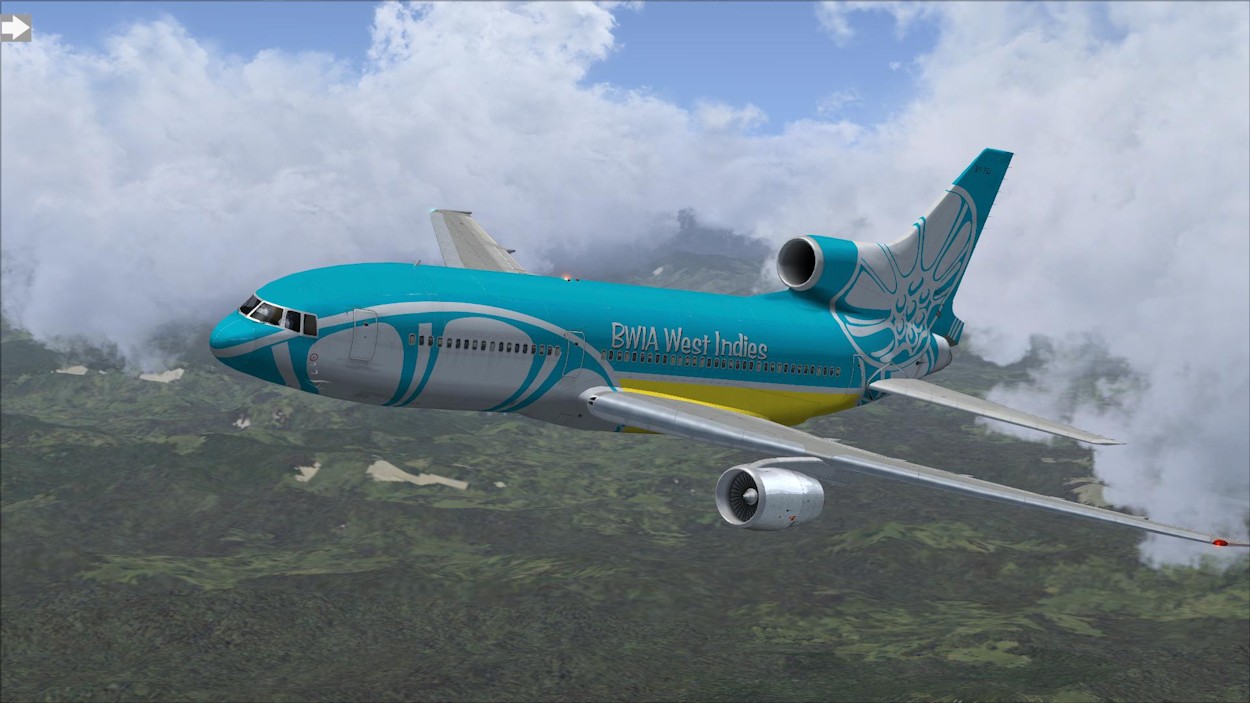
In Flight 1
|
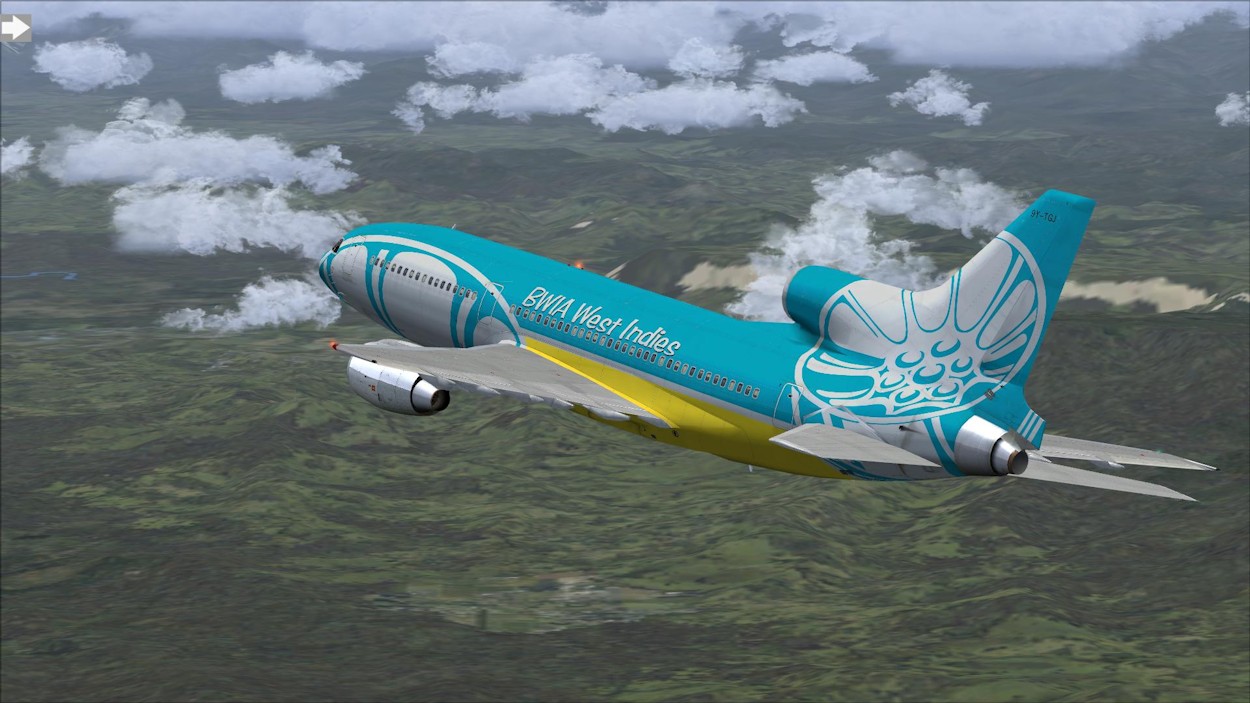
In Flight 2
|
Following the procedures in the manual for a normal take-off and
climb out, the aircraft was established at the cruise altitude and a
cruise speed of Mack 0.83 was established. This cruise setting
produced an endurance consistent with the range characteristics of
the aircraft and with a safe reserve margin. The Test Flight
confirms the modelling of the 'TriStar' Professional for cruise
speed and range performance to be reasonably accurate.
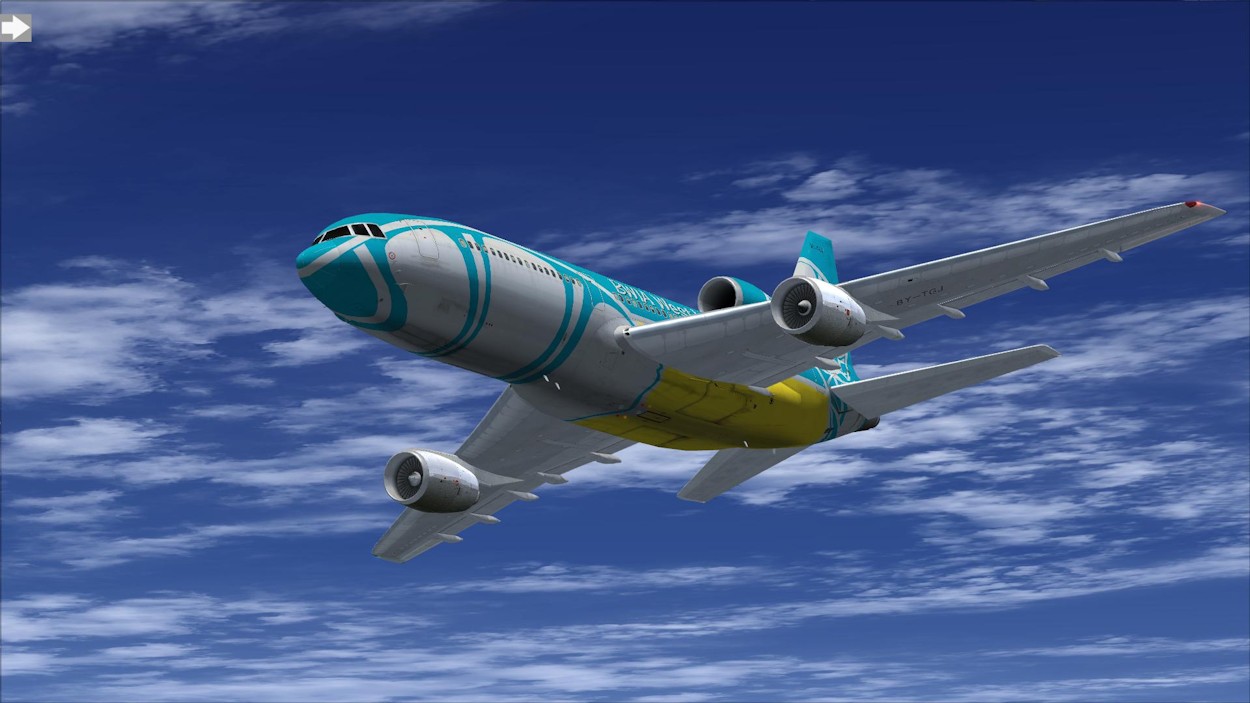
In Flight 3
|
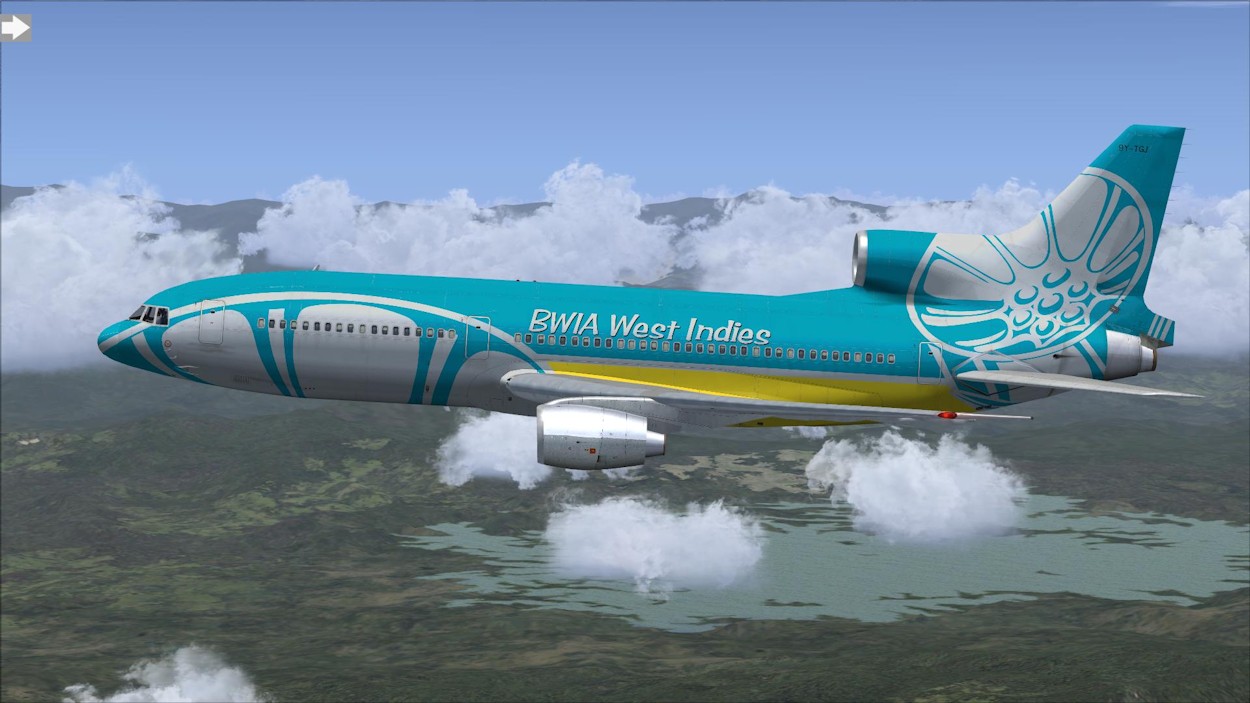
In Flight 4
|
Considering its size, the aircraft was easy to taxi. With a flaps
setting of 'Flaps 10', aircraft rotation occurred at approximately
150 knots indicated air speed (KIAS) and the aircraft easily
maintained a rate of climb and climb speed consistent with the
specified parameters. The climb to cruise altitude was also within
the specified procedure parameters. Configured for landing, the
aircraft’s approach speed was approximately 150 KIAS and it touched
down at approximately 130 KIAS.
In testing the accuracy of the instruments, based on the measured
Test Flight, the speed indications on the airspeed indicator, were
consistent with the averages measured. Additionally, when
establishing a set rate of climb on the vertical speed indicator,
the respective gain in altitude on the altimeter was achieved within
the measured minute, and a standard rate turn was achieved,
consistent with the aircraft type.
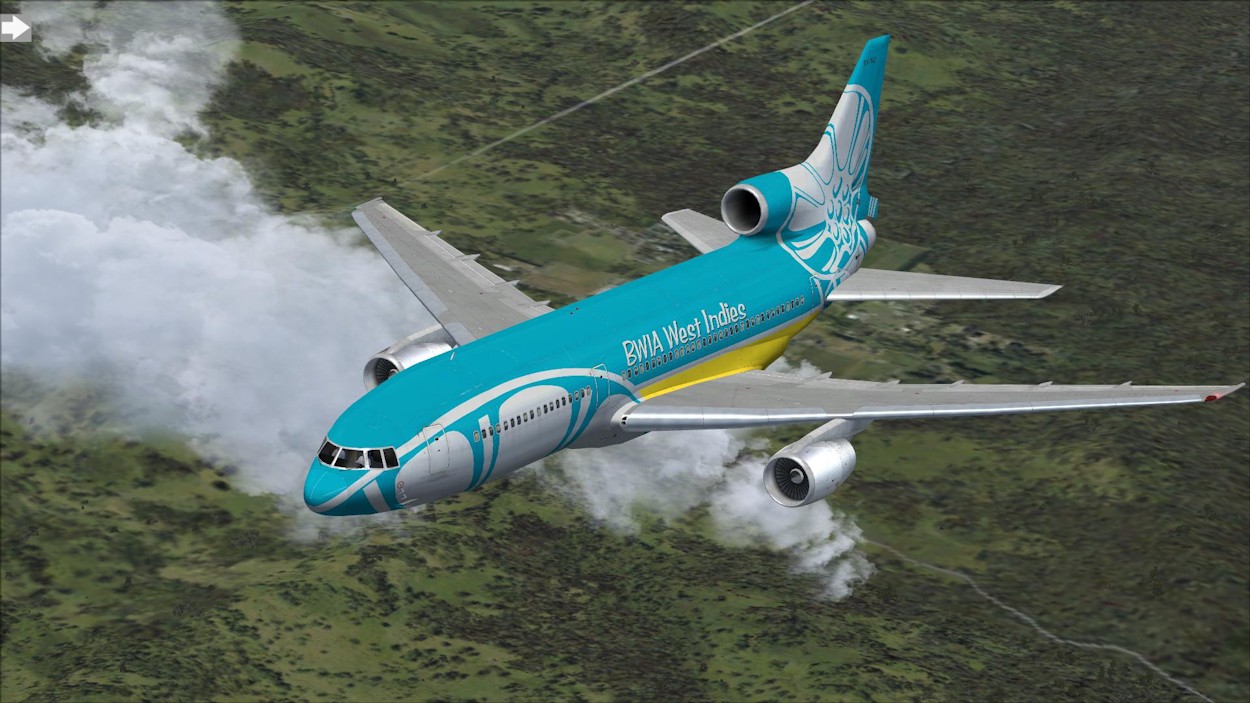
In Flight 5
|
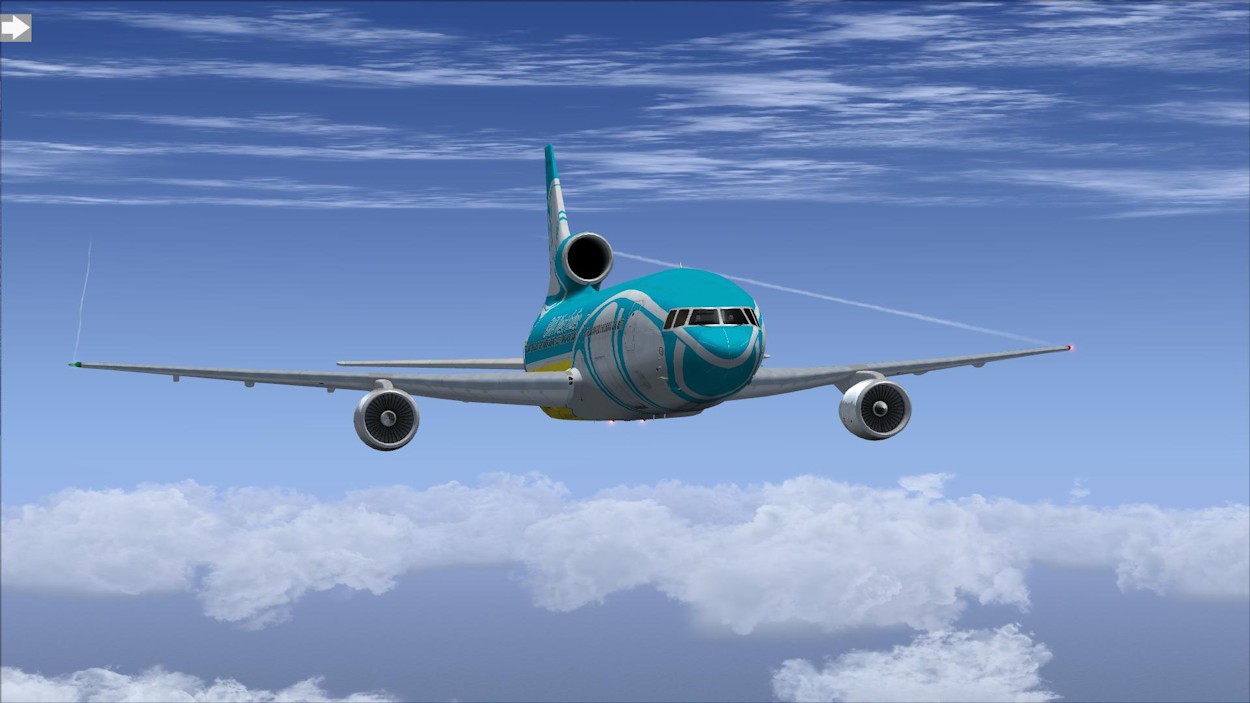
In Flight 6
|
The performance of Just Flight's 'TriStar' Professional was
excellent in flight, displaying the typical flight characteristics
of this wide body aircraft. For a large aircraft, it handles
beautifully, but care must to taken to not fall outside the flight
envelope or you will pay the consequences. Overall, the aircraft
model displays a very accurate rendition of the flight
characteristics and performance of the real world aircraft.
Documentation
The 'TriStar' Professional is provided with a 164 page colour flight
manual in Adobe Acrobat format (.pdf). The documentation is
extremely detailed, providing detailed descriptions of the various
instruments and systems. It also includes a descriptive tutorial
flight, taking you through a full start-up to shut down procedural
sequence, and procedural checklists. This is an excellent manual and
it is good to see such detail provided. This is a valuable resource
and, as I said, a MUST READ at some stage.
Value for Money
Now, some might consider the price a little expensive, but lets be
realistic, for an aircraft with this level of detailed modelling,
for value for money, the 'TriStar' Professional and 'TriStar' Livery
Packs are considered exceptional. With the level of accuracy and
detail in the modelling, it is a fantastic classic commercial
airliner and a pleasure to fly.
Simulator Performance
The aircraft model performed exceptionally within the existing
settings I have in FSX. I have most of my settings set very high and
I also have the TEXTURE_MAX_LOAD entry in the FSX.cfg file set to
2048. There was no need to make any adjustments to these settings
and FSX continued to perform smoothly, as it would with any default
aircraft.
Technical Requirements
Just Flight's 'TriStar' Professional and 'TriStar Livery Packs are
for FSX and Prepar3D v1/v2. Other specified technical requirements
are as follows:
• Windows XP SP2, Vista, or Windows 7;
• Microsoft Flight Simulator FSX with SP2 (or Acceleration Pack)
installed; and
• Pentium V, 2GHz equivalent or higher or any dual core, 2GB RAM,
512MB graphics card, and 6.3GB available HDD space.
Review Computer Specifications
The specifications of the computer on which the review was conducted
are as follows:
• Intel i7 990X Extreme 3.46GHz;
• NVidia GTX580, 1536MB graphics;
• 12GB Kingston DDR3 2000MHz;
• Windows 7, (64bit);
• Microsoft Flight Simulator FSX Acceleration; and
• additional major add-ons include: Active Sky Next, REX Essential
Plus Overdrive; Ultimate Traffic 2; Orbx FTX Global BASE;
Orbx FTX
Global VECTOR; Orbx FTX Global openLC EU; Orbx FTX region series;
and Orbx FTX airport series.
Conclusion
The 'TriStar' Professional and 'TriStar' Livery Packs are a great
offering from Just Flight. The level of detail and systems modelling
provide the flight simmer with the experience of flying and managing
a classic wide body jet of the 1970s. Provided with an excellent and
informative manual, the 'TriStar' Professional displays an excellent
balance of quality and detail at an exceptional price.
This review has involved over 20 hours of specific flight testing
flying hours and it is evident Just Flight have continued to live up
to their reputation with the 'TriStar' Professional. If you are a
fan of commercial airliners and, in particular, classic commercial
airliners of the 1970s, you will thoroughly enjoy the Just Flight
'TriStar' Professional and 'TriStar' Livery Packs.
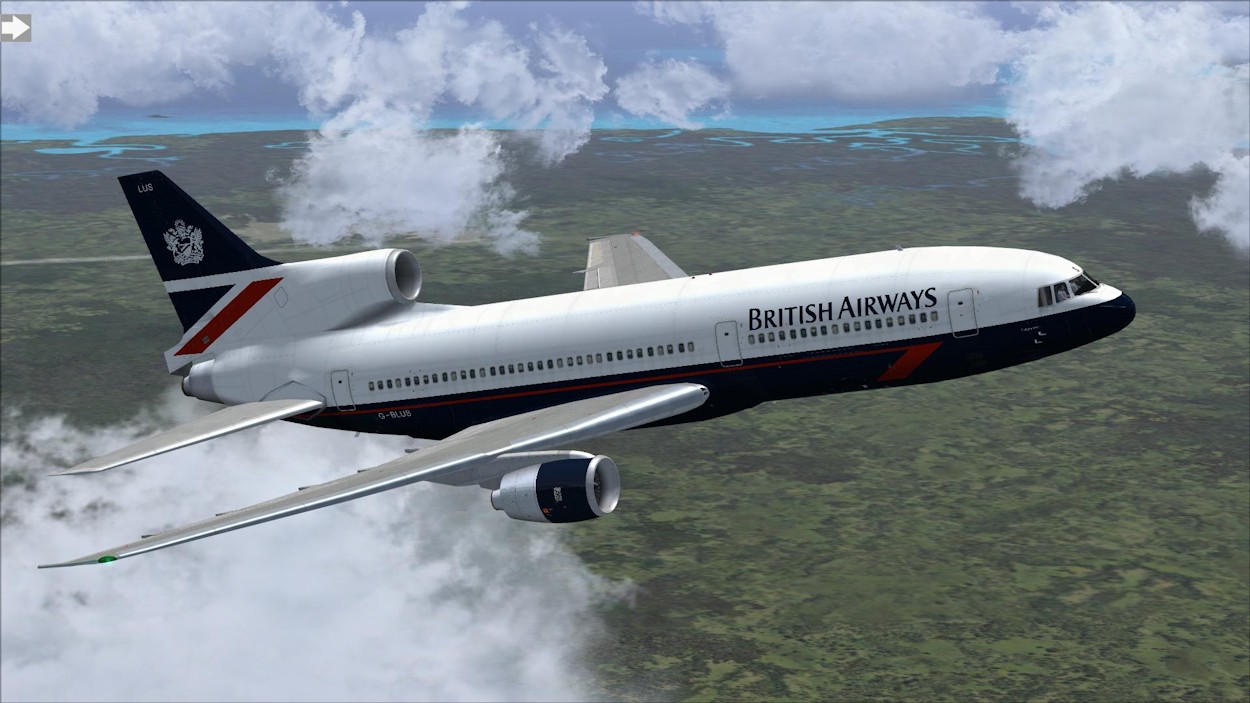
A Classic Airliner
Verdict
The 'TriStar' Professional and 'TriStar' Livery Packs are solid
products which display a high quality and attention to detail and
represent exceptional overall value for money.
Pros:
Quality and attention to detail.
Excellent internal model.
Detailed and fully modelled aircraft systems.
Realistic flight modelling and performance.
Excellent documentation.
Exceptional value for money.
Cons:
No major issues detected.

|
Scores: |
|
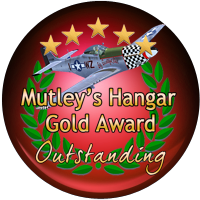 |
|
● External Model: |
9.0/10 |
|
●
Internal Model: |
9.0/10
|
|
●
Sounds: |
9.0/10 |
|
● Flight Characteristics (does it fly by the numbers): |
10/10 |
|
● Flight Dynamics (does it feel like what it looks like): |
10/10 |
|
● Documentation: |
10/10 |
|
● Value for Money: |
10/10 |
The Just Flight 'TriStar' Professional is awarded an overall Mutley’s Hangar score of 9.6/10,
with an "Outstanding" and a Mutley's Hangar Gold Award.
|

.jpg)






















.jpg)




